Vol. 70, No. 11 (2021)
2021-06-05
INVITED REVIEW

INVITED REVIEW
2021, 70 (11): 118101.
doi: 10.7498/aps.70.20210476
Abstract +
Since the correlated insulating states and superconductivity in magic angle twisted bilayer graphene were discovered, the twisted moiré superlattice has attracted a wide range of research interest, and even has brought a new field, “twistronics”, into being. In this review, we first give a history of experimentally discovering magic angle graphene and flat band, and then summarize the recent developments of twisted moiré superlattice, including twisted graphene systems and TMDCs, and finally introduce a notion of moiré superlattice quantum simulator.
REVIEW
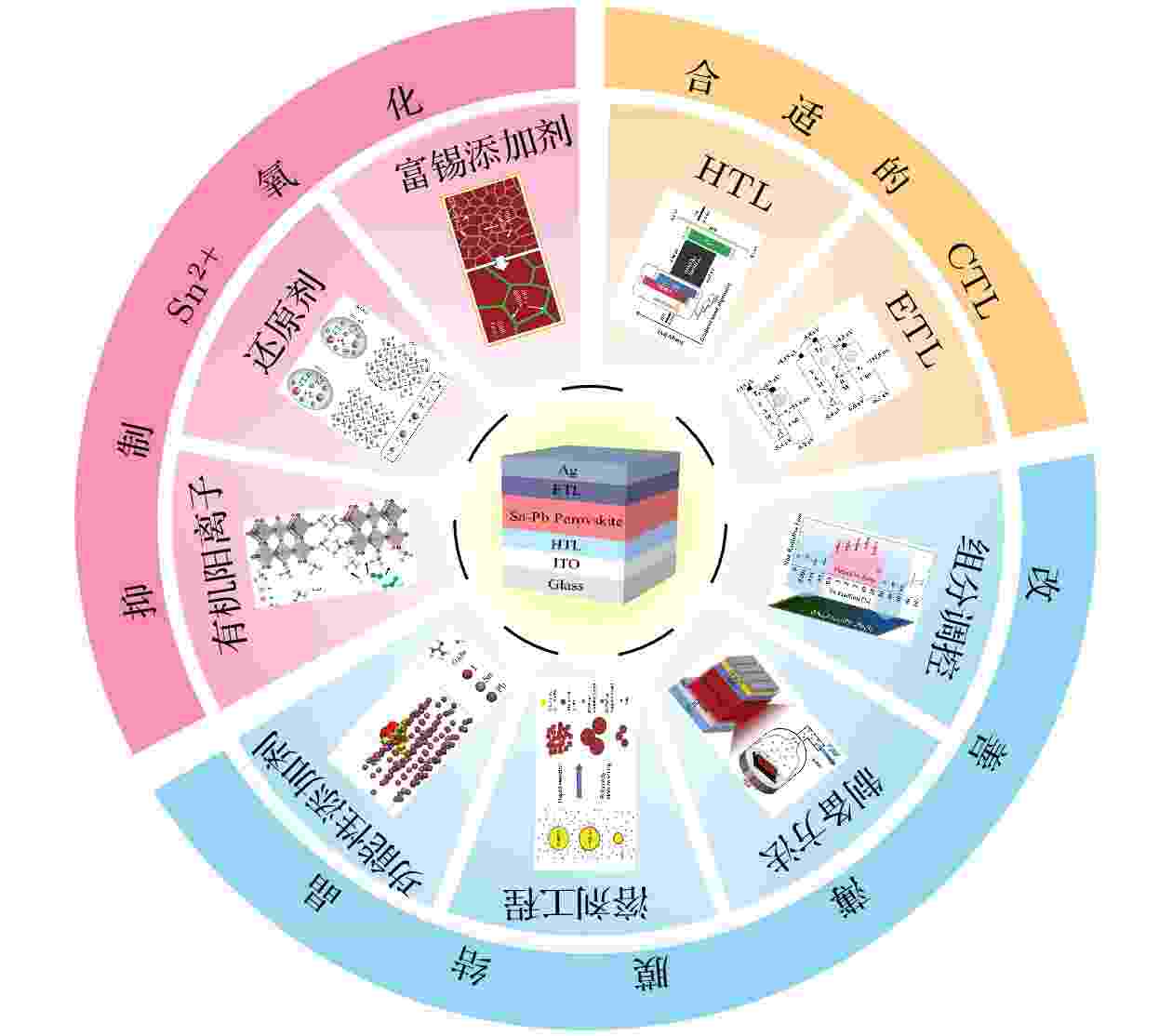
2021, 70 (11): 118402.
doi: 10.7498/aps.70.20201678
Abstract +
In order to break through the limit of Shockley-Queisser (SQ) radiation and further improve the efficiency of perovskite solar cells, tin-lead perovskite solar cells have widely and successfully been used as narrow-bandgap bottom cells in all-perovskite tandem solar cells. The highest efficiency of tin-lead perovskite solar cells has recently reached 21.7%, which, however, is still lower than that of lead-based perovskite solar cells. This article analyzes the main factors that limit the further improving of their performances, and summarizes the effective solutions proposed by researchers in recent years. The main points are as follows: 1) by adding tin-rich additives, strong reducing agents or compounds containing large organic cations, Sn2+ oxidation is inhibited and the p-doped degree of tin-lead perovskite and the open-circuit voltage loss are reduced; 2) through regulating the composition, changing the method of preparing the perovskite film, adding functional groups or solvent engineering, the crystallization rate of tin-lead perovskite film is delayed and the crystallization quality of the film is improved; 3) by selecting an appropriate electron transport layer or hole transport layer the influence of energy level mismatch on carrier transport or the instability of carrier transport layer on devices can be avoided. Finally, the future development of Sn-Pb perovskite solar cells is prospected. It is believed that the tin-lead perovskite solar cells can realize not only the high efficiency and stable single-junction solar cells, but also high efficiency perovskite-perovskite tandem solar cells.

2021, 70 (11): 118801.
doi: 10.7498/aps.70.20201896
Abstract +
In recent years, organic-inorganic hybrid perovskite solar cells (PSCs) have attracted wide attention due to their high photoelectric conversion efficiency and simple preparation process. Hole transport layer (HTL) is one of the most critical components in PSCs. As a kind of inorganic HTL material, nickel oxide (NiOx) has been widely used in perovskite solar cells because of its excellent advantages, such as outstanding chemical stability, high carrier mobility, simple methods for its preparation, etc. In this paper, the applications of NiOx HTL in planar PSCs are systematically summarized from the aspects of the improvment of its structure and photoelectric properties by doping and interface modification. The reasons for affecting the device performances, i.e. fill factor, open-circuit voltage, short-circuit current, photoelectric conversion efficiency, and stability are emphatically analyzed from several aspects, such as energy level matching, hole mobility and crystallinity. In addition, the future development directions of the planar PSCs are prospected.
GENERAL
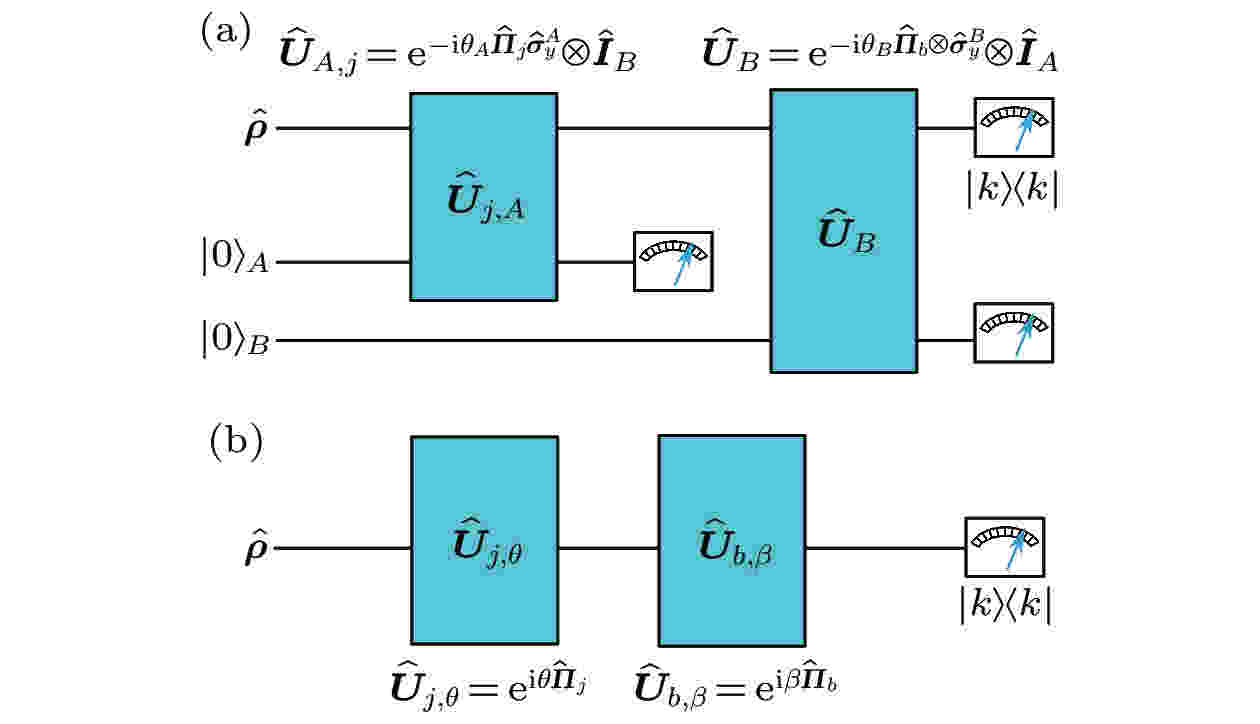
EDITOR'S SUGGESTION
2021, 70 (11): 110301.
doi: 10.7498/aps.70.20210269
Abstract +
Density matrix, which characterizes a quantum state, plays an important role in quantum mechanics. Recently, a method which can directly measure the elements of a density matrix was proposed. Compared with the conventional quantum state tomography which is widely used to reconstruct the density matrix, this measurement method has the advantages of directness and simplicity. However, this direct measurement method relies on an extra pointer space. The addition of this extra pointer can increase the complexity of an experiment. In this paper, we first review previous work on direct measurement, then we propose a scheme to directly measure the density matrix based on δ-quench, which is also a direct measurement method but needs no additional pointer. This proposal reduces the complexity of the measuring system and further simplifies the measurement. We propose two schemes to realize this δ-quench measurement, then analyse their superiorities in different situations of measurement. An experiment to measure photon's density matrix is also designed.

2021, 70 (11): 110302.
doi: 10.7498/aps.70.20202073
Abstract +
Continuous-variable quantum key distribution (CVQKD) is an important application of quantum technology, which enables long-distance communicating parties to establish a string of unconditionally secure keys in an insecure environment. However, in a practical CVQKD system, the finite sampling bandwidth of the analog-to-digital converter (ADC) at the receiver may create inaccurate sampling results, leading to errors in parameter estimation process and leaving a security loophole for eavesdroppers. In order to eliminate the finite sampling bandwidth effect, we propose a peak-compensation-based CVQKD scheme, which estimates the discrepancy between the maximum sampling value and the peak value of each pulse based on the characteristics of Gaussian pulse. The maximum sampling values are compensated by the estimated discrepancy, so that the legitimate parties can obtain correct sampling results. We analyze the influence of the finite sampling bandwidth on the security of the system, expounding the specific steps of peak-compensation, comparing the estimated excess noise before and after peak-compensation, and discussing the security of the system under Gaussian collective attacks. Simulation results show that this scheme can greatly improve the accuracy of pulse peak sampling and remove the finite sampling bandwidth effect. Moreover, the channel parameters estimated by the communicating parties are also corrected by using the compensated values. Compared with the scheme without peak-compensation, this scheme eliminates the limitation of the system repetition to the secret key bit rate, and has longer secure transmission distance and higher secret key bit rate. In addition, compared with other methods of solving the finite sampling bandwidth effect, the proposed scheme can be directly implemented in data processing stage after sampling without any additional devices, and thus increasing no complexity of the system.
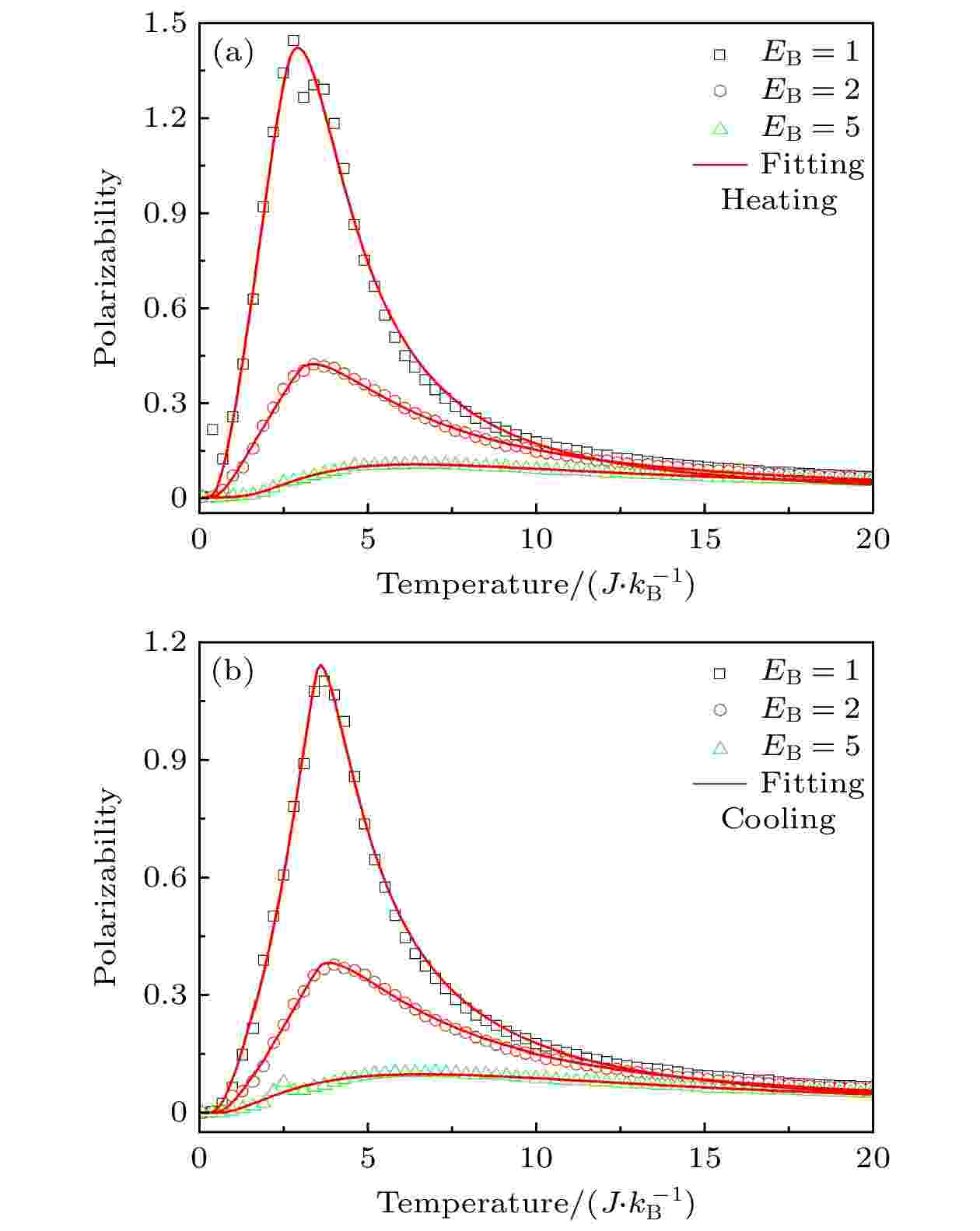
2021, 70 (11): 110501.
doi: 10.7498/aps.70.20202019
Abstract +

EDITOR'S SUGGESTION
2021, 70 (11): 115202.
doi: 10.7498/aps.70.20201946
Abstract +
Aiming at the requirement of the on-line detailed atomic model in radiation hydrodynamic simulations, we propose a general model, multi-average ion collisional-radiative model (MAICRM), to rapidly simulate the ionization and charge state distribution of hot dense plasma under non-local thermal equilibrium (NLTE) conditions. In this model, an average ion is used to characterize the features of all the atomic states at one single charge state, including the average orbital occupation and the total population of the atomic states. The rate equations for the orbital occupations and the population are derived from the rate equations of the detailed configurations and separated into two sets under the two assumptions: one is the single orbital rate coefficients (including no occupation nor hole number of the relative orbital) that are only dependent on the charge state, and the other is the coupling of the excitation/de-excitation process and ionization/recombination process, which are weak. Namely, the orbital occupation of an average ion is mainly determined by the excitation/de-excitation process under a certain density and temperature; the population of the average ions is determined by the ionization/recombination process with the fixed orbital occupation. The two sets of rate equations are solved sequentially and iteratively until a set of converged orbital occupation and population values is obtained. The interplay between the occupation and the population is implicit in the excitation/de-excitation rate coefficient and ionization/recombination rate coefficient, each of which is a function of electron density and temperature as well as occupation. In this work, using the newly developed method and codes, the mean ionizations and charge state distributions of Fe, Xe and Au plasmas under different plasma conditions are calculated and in good agreement with the experimental results and DCA/SCA calculations. Meanwhile, compared with the DCA/SCA calculations, in which hundreds or thousands of detailed atomic states at each charge state are considered to obtain a converged ionization balance, MAICRM only considers one kind of ion at one single charge state, thus the computational cost of MAICRM is much reduced and lower than that of DCA/SCA. Due to its good degree of accuracy for ionization balance and its low computational cost, MAICRM is expected to be incorporated into the radiation hydrodynamic program to realize the online calculation of detailed nonequilibrium atomic models in the future.
NUCLEAR PHYSICS

2021, 70 (11): 112901.
doi: 10.7498/aps.70.20201954
Abstract +
This paper focuses on the feasibility of fast neutron energy spectrum measurement. The MCNPX and Geant4 are used to simulate two conversion models of stacking neutrons to protons in the triple GEM cathode coupled with multilayer polyethylene, with five kinds of single-energy neutron sources and Am-Be continuous neutron sources taken as research objects. The response function to 160 single energy neutrons and the recoil proton spectrum distribution of the above sources of the detection system are obtained by simulation. Using GRAVEL algorithm and MLEM algorithm and through simulation, the recoil proton spectra of six kinds of fast neutron sources are obtained, and they are further analyzed. The spectrum outcome is compared with the standard input spectrum, showing that they are in good agreement with each other. The relative uncertainty of the unfolding spectrum is around 10%–15%. In this part the relation of gas detector with the precision of unfolding spectrum is also discussed. The result shows that when the energy resolution of micro-pattern gas detection is better than 30%, the accuracy of fast neutron spectrum can meet the needs of practical applications. Furthermore, a new transformation model is proposed based on previous experiments and proves the feasibility of applying micro-pattern gas detector to fast neutron detection of simulation. Moreover, spectrum reconstruction can be achieved by using the obtained recoil proton spectrum combined with a suitable inversion algorithm. The modeling and spectrum analysis of this study can provide a different method of applying the fast neutron detection system composed of micro-pattern gas detectors to the detection of unknown fast neutron sources and also to the source recognition through spectrum reconstruction.
ATOMIC AND MOLECULAR PHYSICS

2021, 70 (11): 113101.
doi: 10.7498/aps.70.20201807
Abstract +
The non-equilibrium molecular dynamics (NEMD) method is used to study the thermal conductivities of Si/Ge superlattices with tilted interface under different period lengths, different sample lengths, and different temperatures. The simulation results are as follows. The thermal conductivity of Si/Ge superlattices varies nonmonotonically with the increase of interface angle: when the period length is 4–8 atomic layers, the thermal conductivity for the interface angle of 45° is one order of magnitude larger than those for other interface angles, and the thermal conductivity increases linearly with the sample length increasing and decreases with the temperature increasing. However, when the period length is 20 atomic layers, the thermal conductivity is weakly dependent on sample length and temperature due to the existence of phonon localization.
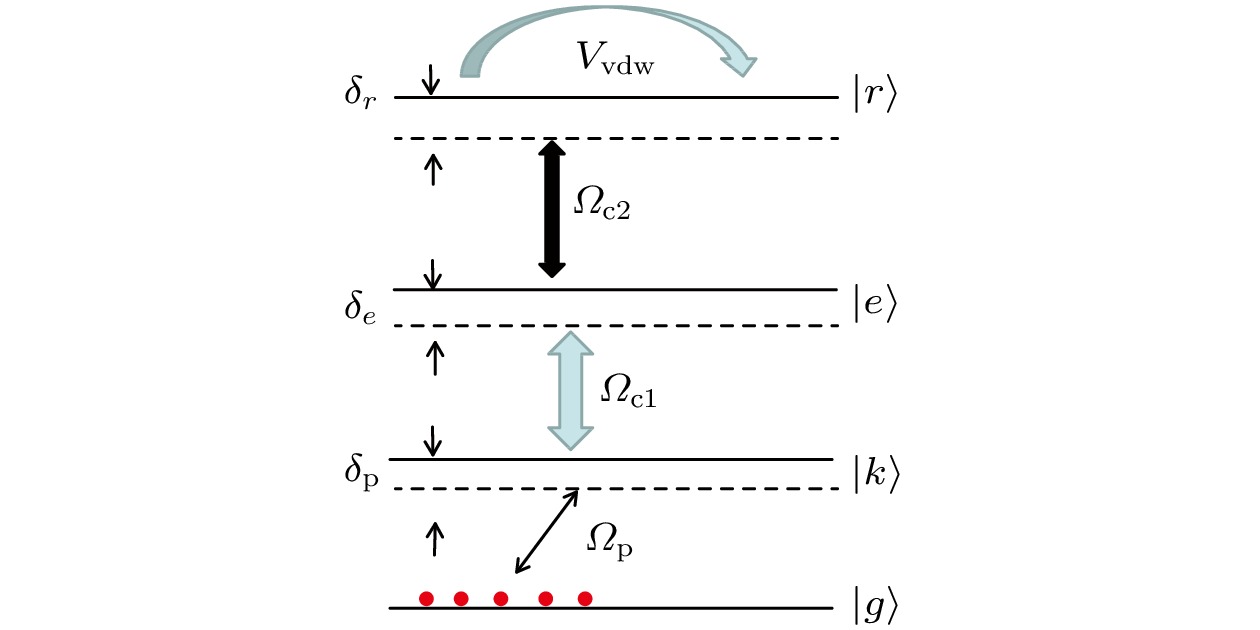
2021, 70 (11): 113201.
doi: 10.7498/aps.70.20202077
Abstract +
In this paper, we study the interaction of a giant ladder type four-level Rydberg atomic system with a weak light field and two strong control fields separately. We use the Monte Carlo method to calculate the dynamic evolution of this system and investigate the influence of dipole-dipole interaction on the transmission spectrum and second-order intensity correlation function of the weak probe field. By changing the value of detuning $\delta_e$ and $\delta_r$ , we can obtain the asymmetric transmission spectrum of the four-level Rydberg atomic system. The influence of Doppler effect on transmission spectrum and second-order intensity correlation function are also studied. By using super atom model, the influences of different incident probe field intensities on the transmission spectrum and the second-order intensity correlation function of probe field are discussed in the Rydberg atomic system. The results show that the transmission spectrum of the four-level Rydberg atomic system is symmetric when the detuning $\delta_e=\delta_r=0$ . We obtain the asymmetric transmission spectrum of the system when the value of detuning $(\delta_e, \delta_r)$ changes from 0 to 43 MHz. In order to evaluate the influence of temperature on the transmission spectrum of the system, the Lorentz distribution function is introduced to calculate the polarizability analytically. And, the influence of temperature on the asymmetric transmission spectrum and the second-order intensity correlation function are discussed at finite temperature separately. The results show that the transmittance of the outgoing probe field at the transparent window decreases with the increase of the intensity of the incident probe light field under the condition of electromagnetically induced transparency. When the intensity of the incident probe field is constant, the asymmetric transmission spectrum can be obtained by changing the detuning of the strong field. In addition, when the propagation direction of the probe field is consistent with that of the strong field, the peak value of the transmission spectrum and the peak value of the second-order intensity correlation function of the system slightly increase as the temperature increases. When the propagation direction of the detection field is inconsistent with that of the strong field, the influence of the Doppler effect on the transmission spectrum and the second-order intensity correlation function of the system can be ignored.

2021, 70 (11): 113202.
doi: 10.7498/aps.70.20201785
Abstract +
The emission time of photoelectrons from atoms, molecules and solids can be accurately measured on an attosecond scale by using two-color two-photon attosecond interferometric spectroscopy, which helps us to understand the ultrafast electronic dynamics in laser-assisted single photoionization. Understanding the photoelectron emission time depends on the physical model, and the relevant theoretical model provides a better physical explanation and numerical prediction for the photoemission time delay. Although the numerical solution of the time-dependent Schrödinger equation can accurately predict the photoelectron emission time, but it cannot provide a physical explanation. Although some other current theoretical models can provide a more reasonable corresponding physical process, the quantitative prediction of the photoemission time delay has a large deviation. Therefore, we improve the exisating eikonal approximation model. Comparing with the existing eikonal approximation model, we use a more accurate final state wave function and calculate the photoelectron trajectory more accurately when calculating the phase accumulated in the photoelectron propagation process, so we can predict the photoemission time delay more accurately. By comparing our numerical simulation results, we find that when the final kinetic energy of photoelectron is low, the calculated results from the existing theoretical model are greatly different from those from the time-dependent Schrödinger equation, reaching tens of attoseconds. The resultsfrom the existing theoretical model are closer to those from the time-dependent Schrödinger equation with the increase of final kinetic energy of photoelectron. However, no matter what the final kinetic energy of the photoelectron is, the difference between the calculation result from the improved eikonal approximation model and that from the time-dependent Schrödinger equation is always very small. Therefore, our improved eikonal approximation model is closer to the results from the time-dependent Schrödinger equation than the existing theoretical model, which greatly deeps our understanding of the ultra-fast process of photoelectron emission.

EDITOR'S SUGGESTION
2021, 70 (11): 113401.
doi: 10.7498/aps.70.20202168
Abstract +
ELECTROMAGNETISM, OPTICS, ACOUSTICS, HEAT TRANSFER, CLASSICAL MECHANICS, AND FLUID DYNAMICS

2021, 70 (11): 114201.
doi: 10.7498/aps.70.20210049
Abstract +
As an important optical element of the optical integration in the future, nanolasers has been a research hotspot in recent years, and the corresponding structural engineering and output characteristics have been widely investigated. However, the nonlinear dynamical performances of nanolasers are rarely reported. Only some preliminary analyses of the dynamic behavior under the optical feedback, optical injection and mutual injection can be found. Some researches pointed out the future prospect of nanolasers, however, some chaos-based applications have not been explored. Therefore, we numerically investigate chaos dynamics in a nanolaser subjected to optical feedback and in another nanolaser subjected to chaotic injection from the former structure by using single mode rate equation, which includes the Purcell cavity-enhanced spontaneous emission factor F and spontaneous emission coupling factor β. The F denotes the ratio of the spontaneous emission rate into the cavity mode to the total spontaneous emission rate in the bulk medium in the absence of a cavity and β represents the fraction of spontaneous emitted photons which are coupled into cavity mode. Specifically, chaos time delay signature (TDS) and unpredictability are evaluated by the peak size of autocorrelation function (ACF) and permutation entropy (PE) respectively. Such kinds of calculations have the advantage of fast operation speed and anti-noise robustness. The results show that the increasing of bias current and the decreasing of gain saturation factor ε, F and β are beneficial to improving the unpredictability and suppressing TDS because the weak damping of the relaxation oscillation leads to strong oscillation. Large linewidth enhancement factor α will increase the number of laser oscillating modes, sideband modes, the spectral components, and enhance the dispersion effect, which will also weaken the information about outer cavity and improve the complexity of chaos. In addition, the above-mentioned chaos properties can be enhanced by injecting the chaos output from a nanolaser subjected to optical feedback into another (slave) nanolaser, which is due to the nonlinear interaction between the driving chaotic signal and the internal electric field of the slave nanolaser. Finally, two-dimensional maps depicting high unpredictability and TDS concealment in the parameter space of the frequency detuning and the injection strength are obtained. It can be found that unpredictability degree can be enhanced by choosing high detuning frequency and intermediate injection strength in the non-injection locking area. The numerical results pave the way for generating the high-quality chaotic sources on a chip or the photonic integrated circuits based on novel semiconductor nanolaser and its related applications.
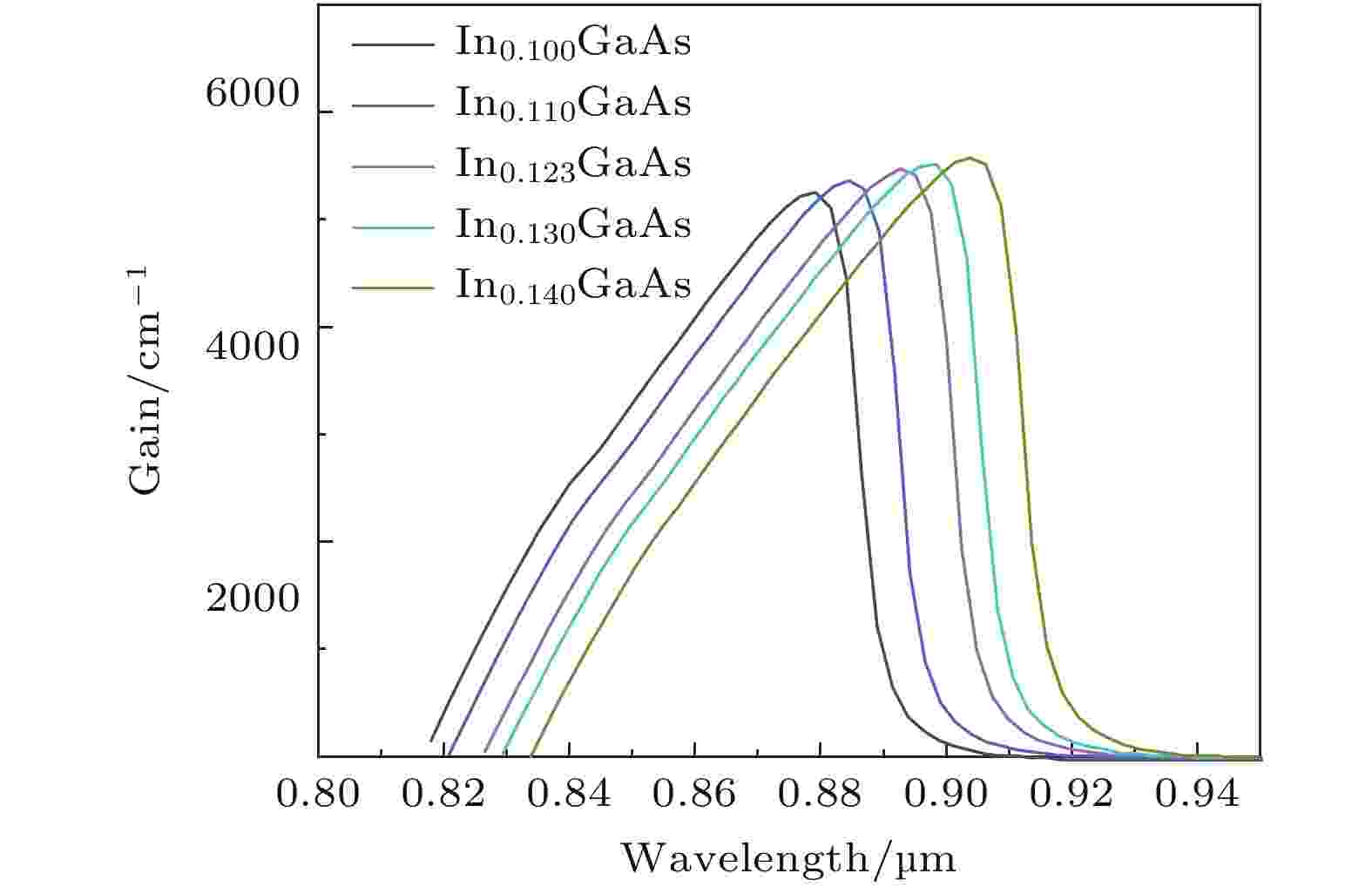
2021, 70 (11): 114202.
doi: 10.7498/aps.70.20210043
Abstract +
Vertical cavity surface emitting lasers (VCSELs) have lots of excellent properties, such as circular beam, low threshold, single longitudinal mode, high speed modulation and monolithic array fabrication capability. The VCSELs have been widely used in data communication and short-distance optical interconnection. In the fields of distance detection and automatic driving, high accuracy lidars have become an indispensable component. In practical applications, 905 nm laser exhibits little absorption by the water vapor in the air. In addition, the 905 nm laser can match with both inexpensive Si detector and high response avalanche photodiode (APD). Therefore, the 905 nm semiconductor laser has become a key light source of lidar. This paper presents the design and fabrication of 905 nm VCSEL with high power conversion efficiency. First, the main factors influencing the power conversion efficiency (PCE) of VCSEL are analyzed theoretically. It is concluded that the slope efficiency contributes to the PCE most. In order to achieve a high slope efficiency, strained InGaAs is used as a quantum well material. Due to the wavelength redshift caused by the thermal effect, the lasing peak wavelength of the multiple quantum well (MQW) is designed to be about 892 nm by optimizing the In composition. The active region consists of three pairs of In0.123Ga0.88As/Al0.3Ga0.7 MQWs. The N-distributed Bragg reflectors (DBRs) are designed to have 40 pairs of Al0.9Ga0.1As/Al0.12Ga0.88As, and the P-DBRs are designed to have 20 pairs of Al0.9Ga0.1As/Al0.12Ga0.88As. The epitaxial structure is designed and grown by metal organic chemical vapor deposition (MOCVD). The cavity mode of the epitaxial wafer is around 903.7 nm. The photoluminescence (PL) spectrum is also measured. The peak wavelength is approximately 893.7 nm, and the full width at half maximum is 21.6 nm. Then, the 905 nm VCSELs with different apertures (6–18 μm) are fabricated via semiconductor technologies such as photolithography, evaporation, inductively coupled plasma (ICP), wet oxidation, electroplating, etc. Finally, the L-I-V characteristics and spectra of VCSELs with different apertures are tested. The obtained maximum slope efficiency and PCE of the devices are 1.12 W/A and 44.8%, respectively. In addition, the influences of aperture size on the far-field profiles and spectra of the devices are investigated. These 905 nm VCSELs with high PCE are potential for the miniaturization and lowing the cost of LiDAR.

2021, 70 (11): 114203.
doi: 10.7498/aps.70.20201641
Abstract +
Error compensation is an important guarantee method to ensure the accuracy of clock synchronization in underwater sensor networks. Existing research methods mainly use linear fitting and least square method to compensate for clock synchronization parameters. Underwater wireless sensor network nodes are mobile, which leads the network nodes to be always in a time-varying state. In the process of synchronous forwarding, the position where the node sends and receives data packets will change, resulting in a relative moving distance, leading the dynamic delay to an increase in. In this way, as the number of forwarding nodes increases, the error of the clock gradually increases, causing the synchronization accuracy of the underwater sensor wireless network to gradually decrease. The existing underwater wireless sensor network clock synchronization algorithm does not fully consider the dynamic time delay caused by the movement of the node with the ocean current. It only uses the time stamp mechanism to solve the clock synchronization parameters, and then uses the traditional linear fitting to refine the synchronization parameters. The accurate solution of dynamic time delay is a key factor of synchronization accuracy. The use of traditional optimization algorithms to refine the synchronization parameters can easily fall into a local optimum, which makes the synchronization accuracy not high. Therefore, the existing traditional research on clock synchronization algorithms cannot well solve the problem of clock synchronization accuracy caused by node mobility. However this type of method does not consider the clock synchronization accuracy of node movement affected by ocean currents. To solve this problem, this paper proposes a clock synchronization error compensation algorithm based on BP neural network model. First, the deep-sea Lagrangian ocean current model is used to describe the movement of underwater nodes and simulate the movement speed of underwater nodes, and then a clock synchronization parameter model is established, and finally a BP neural network clock synchronization error compensation model is build, which conforms to the underwater environment, and the excitation function is defined, and regular term factor and compensatory factor are introduced to avoid model over-fitting. The BP neural network model clock synchronization error compensation algorithm is established for error back propagation. Simulation experiments show that compared with the comparison algorithm TSHL, MM-sync, and MU-sync, the accuracy of clock synchronization, namely the error between clock synchronization time and standard time, increased by 37.42%, 17.29% and 21.86%, and the mean square error is significantly reduced.
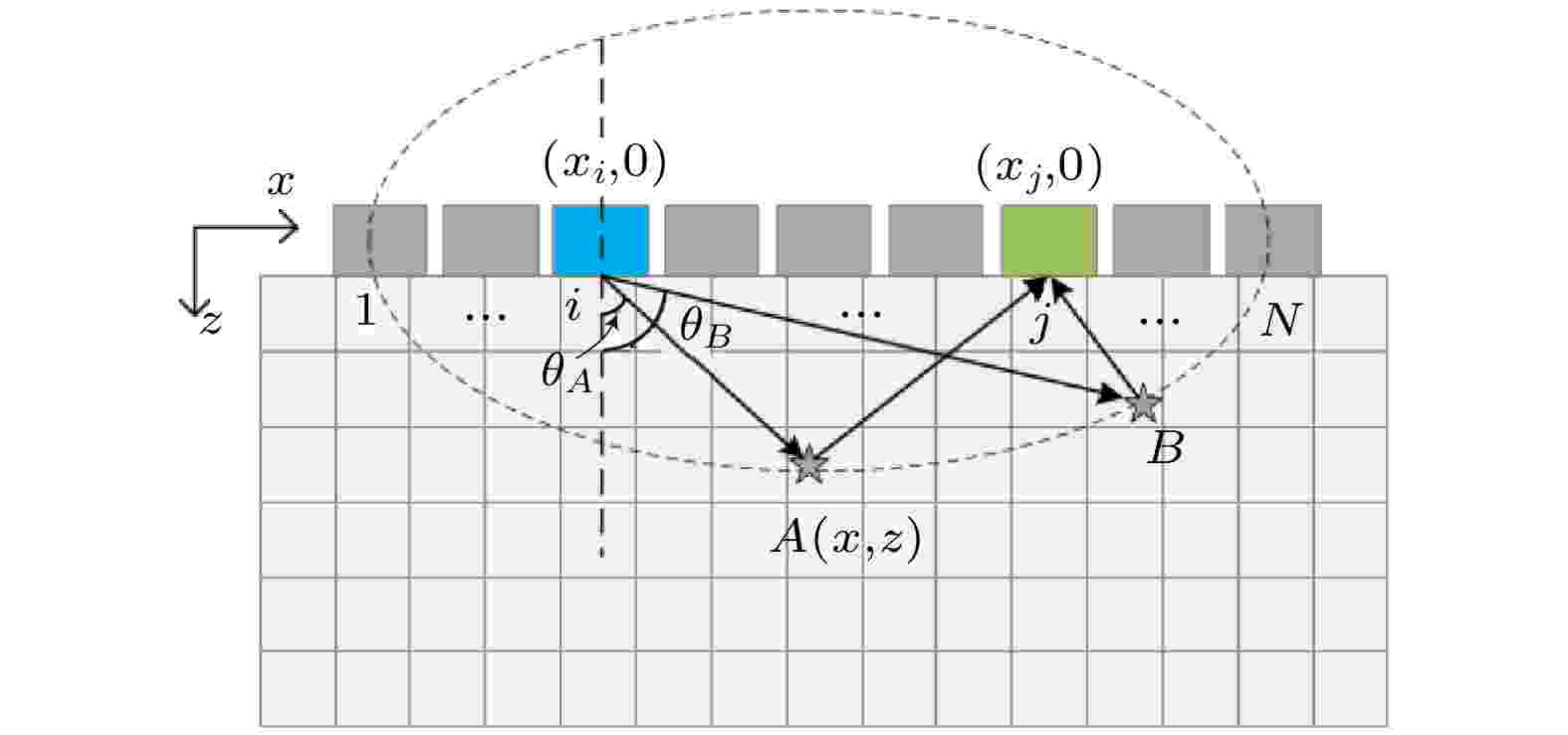
2021, 70 (11): 114301.
doi: 10.7498/aps.70.20210032
Abstract +

2021, 70 (11): 114302.
doi: 10.7498/aps.70.20202093
Abstract +
The formula for the nonlinear propagation of harmonics is obtained by using the generalized Navier-Stokes equations and the modified equations of state, considering the presence of heat transfer and fluid viscidity. The quantitative relationship among the harmonic pressure, initial sound pressure amplitude, frequency and the media property is obtained by approximately solving the single-frequency acoustic equation. In this paper, the hamonics’ distributions and propagations in the radiation field of single- and double-frequency sound source with different driving pressures and frequencies are discussed. It is found that new harmonics constantly appear in the sound field, and each-order harmonic of excitation gradually increases and then weakens with the increase of distance. The amplitude of harmonic pressure increases with the increase of the driving acoustic pressure near the sound source, but decreases with the increase of the frequency. Compared with the single-frequency field, the dual-frequency field has a large propagation distance, a very uniform acoustic energy distribution, and a large harmonic content in the far-field when the input total sound energy is constant. The physical mechanism is that the higher driving frequency causes a faster acoustic loss, a slower harmonic accumulation, and a smaller sound propagation distance. The higher driving pressure causes the much fundamental sound energy to be transferred, the more harmonics to be generated, the fundamental wave to be attenuated faster, and the negative effect of sound pressure on far-field sound energy to be increased. Through the analysis, it is found that the multi-frequency sound source can increase the propagation distance of sound, and improve the uniformity of sound energy distribution.

2021, 70 (11): 114303.
doi: 10.7498/aps.70.20201858
Abstract +
Since the earth is approximately a sphere, the sound speed equivalent surface on the range-depth plane is not a parallel plane, but a concentric sphere at a long distance. Therefore, for a long-range sound propagation, the effect of the curvature of the earth cannot be ignored. In this paper, conformal mapping is used to propose a method of earth curvature correction without changing the existing sound field calculation model, and has the characteristics of good portability and simple calculation. The simulation results in a typical environment show that because of the earth curvature, the location of the convergence zone moves toward the sound source, and its movement can reach 10 km at 1000 km in distance. Before and after the earth curvature correction, the transmission loss difference can reach up to 15 dB at a particular location. Through the analysis of the simulation results in four typical sound speed profiles in Northwest Pacific Ocean, it is found that the movement of the convergence zone and the distance change are approximately linear, and the movement of the convergence zone increases by about 1km for every increase of the propagation distance by 100 km. For deep-sea channel propagation, the earth curvature will cause the arrival structure to move forward as a whole on the time axis, and the degree of the forward motion will gradually increase with the distance increasing. At 1000 km, the amplitude of the forward motion can reach 136 ms. In addition, the earth curvature will also cause the depth and time extension of the arrival structure. For the received time-domain waveform at a certain depth, there is a big difference between before and after the earth curvature correction. The modified results from different earth approximation models show that the accuracy of the calculation can be satisfied by approximating the earth as a standard sphere.

EDITOR'S SUGGESTION
2021, 70 (11): 114304.
doi: 10.7498/aps.70.20201878
Abstract +
With the advantages of non-radiation and low-cost, ultrasound imaging has been widely used in clinical diagnosis. However, due to the compromise between temporal and spatial resolution, the traditional ultrasound imaging method which collects images line by line fails to obtain the images at a high frame rate. Ultrafast ultrasound imaging method based on the plane-wave emission can achieve a high frame rate with the capability for instantaneous hemodynamic imaging of neurovascular response. Besides, by the coherent compounding of the echo signals received from emitting a set of tilting plane-waves, the image quality can be improved in terms of resolution, contrast and signal-to-noise ratio (SNR). Considering the fact that received signals are the mixture of echo signals from the low-speed soft tissue and high-speed blood flow, a clutter filtering method is used to remove the signals of soft tissue. In this study, the ultrafast ultrasound sequence of emission and reception is designed to image the spinal cord by using the groups of multiple steering-angle plane-waves. The so-called f-k migration algorithm based on an exploding reflector model (ERM) is used for coherent plane-wave compounding. Eigenvalue decomposition (EVD) is then applied to tissue and blood signal extraction. The static tissue signals correspond to eigenvectors with low Doppler frequency shift and large magnitude eigenvalue while the high-speed blood flow signals correspond to eigenvectors with high Doppler frequency shift and small eigenvalue. Therefore, frequency and amplitude thresholds can be applied to the accurate separation of the blood component and the tissue component. After the signal extraction, the hemodynamic imaging of blood vessels can thus be obtained from the power Doppler results. The experiments are carried out by using a programmable ultrasonic array system and a high-frequency linear array transducer L22-14vX with a central frequency of 15.625 MHz. The sample acquisition frequency is set to be 62.5 MHz. In rat experiments in vivo, 14040 angle-stilting images per second are compounded into 520 images, each of which is compounded from 27 tilting images (the tilting angles ranging from –10° to 10°). The experiments are conducted on the anesthetized rats with part of the vertebral plate removed. The ultrafast B-mode images are acquired from a 14.0 mm ×12.7 mm region-of-interest. The 520 frames acquired in one second are processed by the clutter filter based on eigenvalue decomposition and Doppler shift analysis. The eigenvectors and eigenvalues corresponding to the soft tissue are discarded. The power Doppler images of the spinal cord micro-vessels are obtained. The experimental results indicate that the ultrafast ultrasound Doppler imaging method is effective for monitoring the hemodynamic variation in spinal cord. The micro-hemorrhage can be identified from the power Doppler images. The quantitative results indicate that the SNR increases with the steering angles increasing. Compared with the results obtained by using 9 steering angles, 5 dB SNR enhancement can be obtained by using the 27 steering angles. In conclusion, the ultrafast ultrasound Doppler technology has the potential applications in spinal cord microvascular imaging and hemodynamic evaluation of neurovascular function of spinal cord.
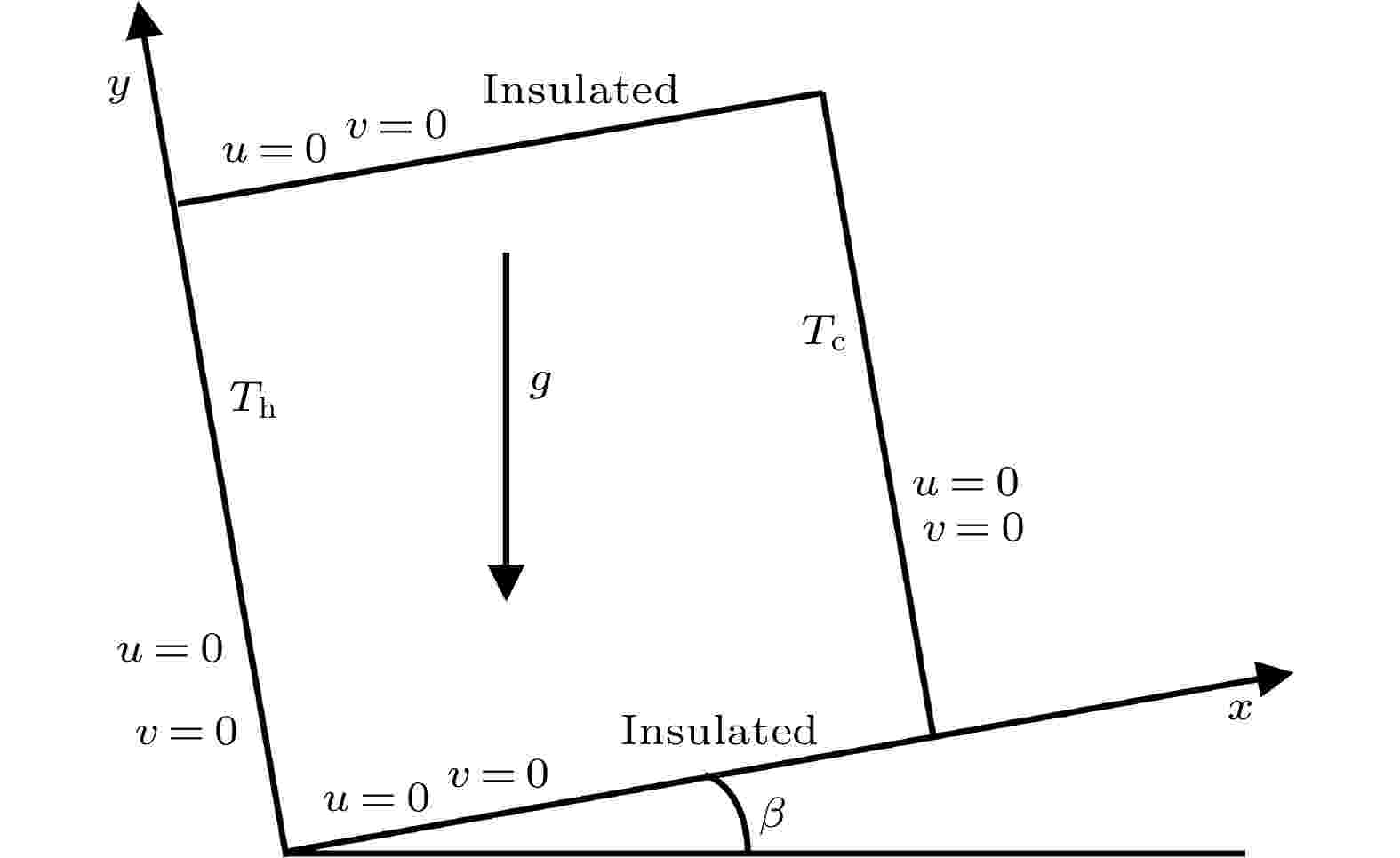
2021, 70 (11): 114401.
doi: 10.7498/aps.70.20201513
Abstract +
Heat transfer of natural convection in inclined cavities is one of the hot research topics in nonlinear non-equilibrium systems. In this paper, direct numerical simulations of natural convection in an inclined square cavity are carried out by using a high-accuracy numerical method. The effects of the different trends of inclination angle in a range of 0°–180° on the nonlinear evolution of flow field, heat transfer efficiency, and bifurcation are investigated. The Rayleigh number varies in a range from 103 to 106. The results show that the heat transfer efficiency characterized by Nusselt number is highly dependent on the Rayleigh number, Prandtl number, and the inclination angle. When the Rayleigh number is high, the Nusselt number will have a small jump near the inclination angle in a range of 80°–100°. The evolution of the flow field and temperature field are more complicated at high Rayleigh number. There are one to three vortices of different intensities in the cavity. At low Rayleigh number and inclination angle of the cavity being close to 90°, the flow state is composed mainly of heat conduction state. In addition, it is found that there exist two stable branches of solutions in a range of Rayleigh number (4949, 314721) when the inclination angle is in the interval of (70°, 110°).

2021, 70 (11): 114701.
doi: 10.7498/aps.70.20201960
Abstract +
In this paper, we numerically investigate the late-time growth of high-Reynolds-number single-mode Rayleigh-Taylor instability in a long pipe by using an advanced phase-field lattice Boltzmann multiphase method. We mainly analyze the influence of surface tension on interfacial dynamic behavior and the development of the bubble front and spike front. The numerical experiments indicate that increasing surface tension can significantly reduce the complexity of formed interfacial structure and also prevents the breakup of phase interfaces. The interface patterns in the instability process cannot always preserve the symmetric property under the extremely small surface tension, but they do maintain the symmetries with respect to the middle line as the surface tension is increased. We also report that the bubble amplitude first increases then decreases with the surface tension. There are no obvious differences between the curves of spike amplitudes for low surface tensions. However, when the surface tension increases to a critical value, it can slow down the spike growth significantly. When the surface tension is lower than the critical value, the development of the high-Reynolds-number Rayleigh-Taylor instability can be divided into four different stages, i.e. the linear growth, saturated velocity growth, reacceleration, and chaotic mixing. The bubble and spike velocities at the second stage show good agreement with those from the modified potential flow theory that takes the surface tension effect into account. After that, the bubble front and spike front are accelerated due to the formation of Kelvin-Helmholtz vortices in the interfacial region. At the late time, the bubble velocity and spike velocity become unstable and slightly fluctuate over time. To determine the nature of the late-time growth, we also measure the bubble and spike normalized accelerations at various interfacial tensions and Atwood numbers. It is found that both the spike and bubble growth rates first increase then decrease with the surface tension in general. Finally, we deduce a theoretical formula for the critical surface tension, below which the Rayleigh-Taylor instability takes place and above which tension it does not occur. It is shown that the critical surface tension increases with the Atwood number and also the numerical predictions by the lattice Boltzmann method are also in accord well with the theoretical results.
PHYSICS OF GASES, PLASMAS, AND ELECTRIC DISCHARGES
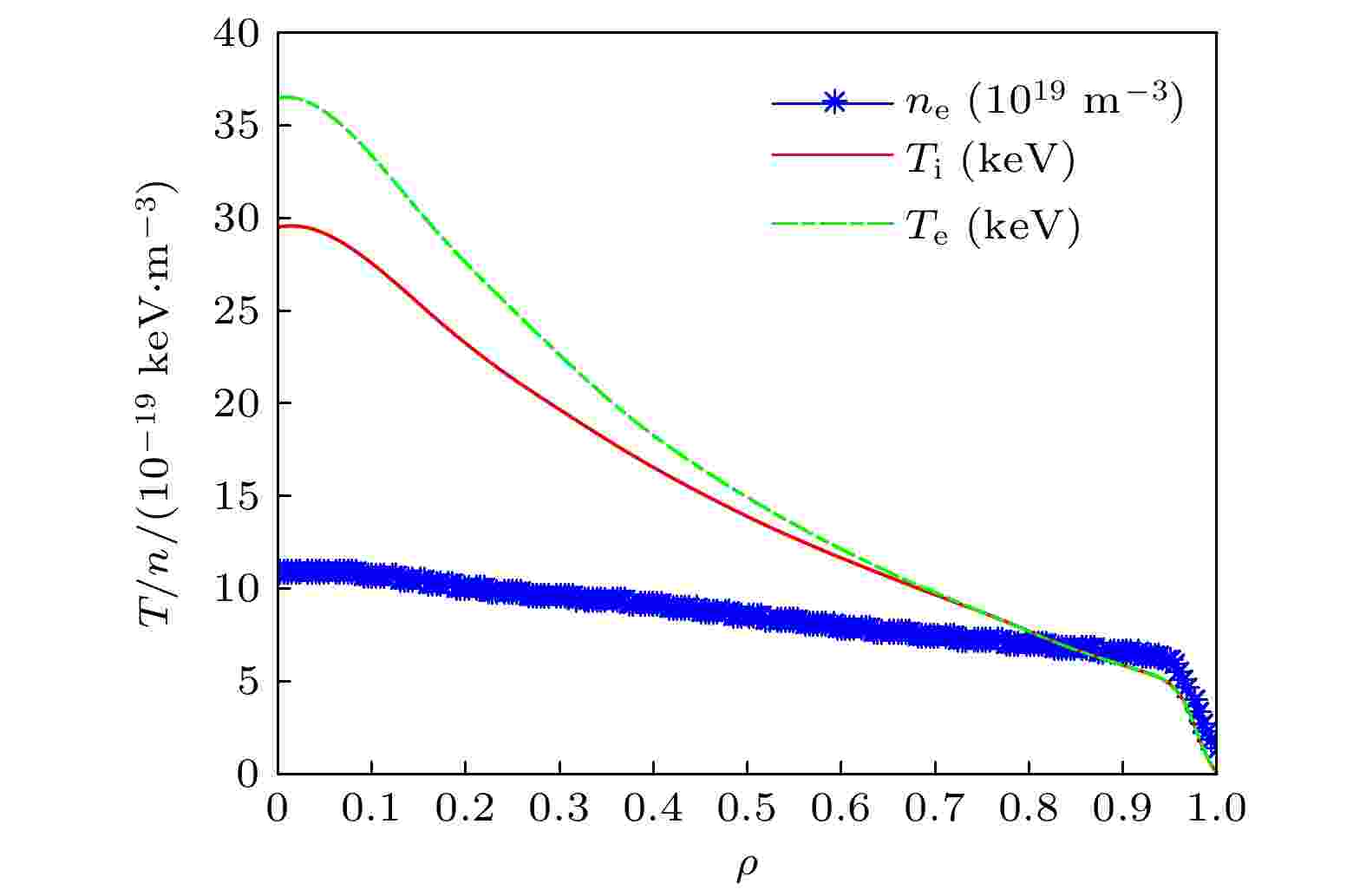
2021, 70 (11): 115201.
doi: 10.7498/aps.70.20201972
Abstract +
Confinement of fusion born alpha particles in tokamak is the key issue to burning plasma. Apart from toroidal field ripple, instabilities can induce energetic particles to lose and be redistributed. Based on the parameters of China Fusion Engineering Testing Reactor (CFETT) hybrid scenario, alpha particle distribution and neoclassical tearing mode structure, the alpha particle loss induced under perturbation of ripple and neoclassical tearing mode (NTM) is calculated with the guiding center code ORBIT. The inputs have the initial distribution of alpha particles which is obtained with the TRANSP/NUBEAM code, the static NTM perturbation with different amplitudes which is obtained from TM1 code, and the ripple field from engineering design. The results show that the heat load on last closed flux surface is about 0.1 MW/m2, with ripple and collision included. The collisionless stochastic ripple diffusion is the main loss channel of initial alpha particle distribution in the CFETR, and the ripple perturbation has no influence on passing particles. The loss fraction does not increase with the NTM perturbation amplitude increasing, the synergistic effect is negligible. The scanning of ripple amplitude shows that the synergistic effect is slight. The monoenergetic initial distribution of alpha particles can give different types of orbits in the plane of ($ {P_\zeta },\mu $ ), such as the domains of trapped particle and passing particle, lost particle and confined particle. The trapped fraction of initial alpha particles is about 27%, ripple loss region in phase space is narrow and away from the main trapped particle distribution. The increasing of ripple perturbation in simulation does enlarge the ripple loss domain in the phase space ($ {P_\zeta },\mu $ ), which is corresponding to a lager ripple loss fraction and has more trapped-passing boundaries. The NTM perturbation does enlarge the orbit excursions of trapped particles, and thus increasing the trapped passing transition near the boundary. The slight synergistic effect in calculation with larger ripple amplitude is explained by ripple loss region having more trapped-passing boundaries, not by the profile flattening of trapped particles. The NTM perturbation and finite collision can transit the passing particle to trapped particle near the boundary. With the help of kinetic Poincare plot, neither direct particle loss nor profile flattening of trapped particles is observed. The loss fraction enhancement can happen only when the profile flattening of trapped particles takes place within the ripple loss region, which is not the case in CFETR. The conclusion of this work contributes a lot to the design of CFETR and the study of alpha particle physics.
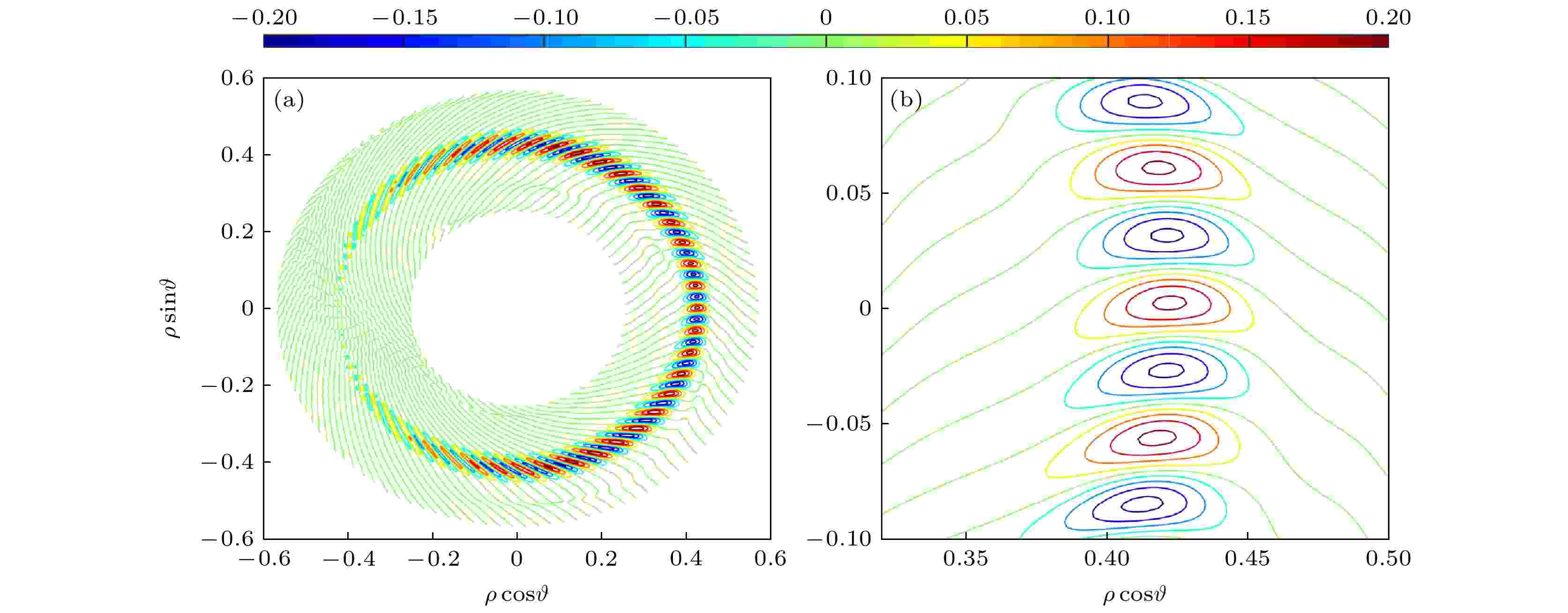
2021, 70 (11): 115203.
doi: 10.7498/aps.70.20202003
Abstract +
The multiple scale derivative expansion method is used to manipulate the electron drift kinetic equation, following the theoretical framework of drift wave–zonal flow system developed by Zhang et al. [Zhang Y Z, Liu Z Y, Mahajan S M, Xie T, Liu J 2017 Phys. Plasmas 24 122304 ]. At the zeroth order it is the linear eigenmode equation describing the trapped electron mode on a mirco-scale. At the first order it is the envelop equation for trapped electron mode modulated by the zonal flow on a meso-scale. The eigenmode equation has been solved by Xie et al. [Xie T, Zhang Y Z, Mahajan S M, Wu F, He Hongda, Liu Z Y 2019 Phys. Plasmas 26 022503 ] to obtain the eigenvalue and two-dimensional mode structure of trapped electron mode. These are essential components in calculating group velocities contained in the envelop equation. The radial group velocity arises from the geodesic curvature of magnetic field in tokamak. The poloidal group velocity stems from the normal curvature and diamagnetic drift velocity, which yields the mapping between the poloidal angle and time. Since the radial group velocity is also a function of poloidal angle, it is mapped to a periodic function of time with a period of milliseconds. The numerical results indicate the rapid zero-crossing, which is significant in the drift wave – zonal flow system and provides a sound foundation for studying zonal flow driven by trapped electron mode.

2021, 70 (11): 115204.
doi: 10.7498/aps.70.20202113
Abstract +
The capacitively coupled Ar plasma containing oxygen, driven by a radio frequency of 27.12 MHz, is investigated by laser-induced photo-detachment technique assisted with a Langmuir probe. The plasmas with different amounts of oxygen are obtained by changing the flow of Ar and oxygen, each of which is controlled by a mass flow controller. The axial distribution of plasma characteristic can be measured by changing the relative axial position of the Langmuir probe between the parallel electrodes. The electron density and electron temperature are calculated from the current-voltage curve measured by the scanning Langmuir probe, and the electronegativity is obtained from the current curves of the probe with the laser-induced photo-detachment technique. The negative ion density can be calculated from the electron density and the electronegativity. It is shown that with oxygen flow rate increasing, the dissociative attachment of oxygen molecules with electrons will consume the electrons with the middle energy in the electron energy probability function (EEPF) measured by Langmuir probe. The EEPF evolves from Druyvesteyn to Maxwellian distribution due to the thermalization by the e-e interaction with applied power increasing. It is worth mentioning that a depression in the EEPF curve will appear when discharging high-pressure Ar gas containing oxygen. This depression can also be caused by the dissociative attachment of oxygen molecules with electrons where the threshold energy is around 4.5 eV. The axial profile of the electron density is calculated from the EEPF changing from a linear rise in pure Ar plasma to a flater phase of the distribution due to the negative ions such as oxygen introduced into the plasma. The electron temperature changes a little at different axial positions. The rise of negative ion density nearby the sheath of powered electrode is due to the dissociative attachment caused by the collision of oxygen molecules with energetic electrons. In addition, the axial distribution of electronegativity takes on a shape of spoon, which results from the consequence of generation and loss of negative ions in the process of the ambipolar-electric-field-driven diffusion to the plasma center.
CONDENSED MATTER: STRUCTURAL, MECHANICAL, AND THERMAL PROPERTIES
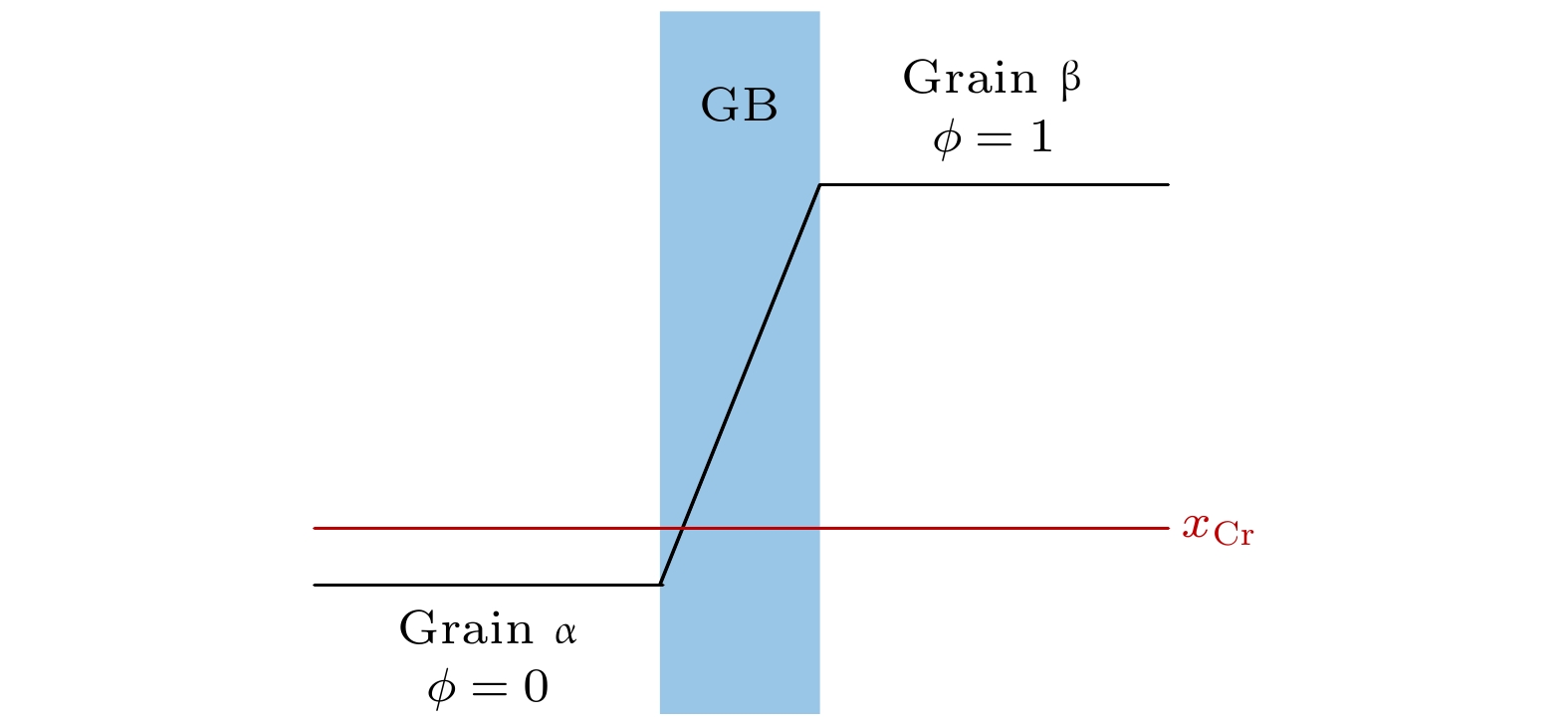
2021, 70 (11): 116101.
doi: 10.7498/aps.70.20201840
Abstract +
Ferritic/martensitic steel, with Cr atomic content in a range of 7%–15%, is a promising candidate for advanced nuclear power systems, due to its swelling resistance and creep fracture resistance under irradiation. Under thermodynamic conditions, Cr segregation usually occurs at grain boundary (GB) in Fe-Cr alloys. However, irradiation can greatly accelerate this process. The enrichment of Cr at GB will enhance precipitation, resulting in embrittlement; while the depletion of Cr at GB may greatly weaken the corrosion resistance properties. In the present work, thermodynamic segregation and radiation-enhanced segregation of Cr element at GB in Fe-Cr alloy is investigated by using the Wheeler-Boettinger-McFadden (WBM) phase-field model. The simulation results show that temperature has a great influence during thermodynamic segregation of Cr at the GB without radiation: when the temperature is lower than 500 ℃ the segregation amount of Cr at the GB is relatively small; when the temperature is higher than 500 ℃ the Cr concentration at GB increases significantly. In addition, as the concentration of Cr in the matrix increases, the amount of relative increase of Cr concentration at GB decreases. However, the Cr concentration at GB under irradiation is significantly enhanced, compared with the counterpart without irradiation. With the increase of dose rate, the Cr concentration in the center of GB also increases. Moreover, with the increase of Cr concentration in the matrix, the relative increase of the Cr concentration at the GB weakens.

2021, 70 (11): 116102.
doi: 10.7498/aps.70.20202028
Abstract +
The single event effect (SEE) and the total ionizing dose (TID) effect of a commercial enhancement mode gallium nitride (GaN) high electron nobility transistor (HEMT) with p-type gate structure and cascode structure are studied by using the radiation of heavy ions and 60Co gamma in this paper. The safe operating areas ofSEE, the sensitive parameters degradation of TID effect and the SEE and TID characteristics of GaN HEMT device are respectively presented. The experimental results show that the SEE and TID effect have less influence on the p-type gate GaN device. The linear energy transfer (LET) threshold of the single event Burnout effect (SEB) is higher than 37 MeV·cm2/mg and the failure threshold of TID effect is above 1M rad (Si) for p-type gate GaN device. However, the GaN HEMT device with cascode structure is much more sensitive to SEE and TID effect than p-type gate GaN device. Under heavy ions at LET of 22 MeV·cm2/mg and a cumulative dose of 200 krad (Si), the SEB phenomenon and parameters-degradation of cascode-type GaN HEMT are respectively observed. Besides, the circuit structure of the cascode-type GaN HEMT device is analyzed by using metallographic microscope imaging and focused ions beam technology. It reveals the possible reason why it is sensitive to SEB and TID for cascode-type GaN HEMT. These results show that the extra carriers caused by heavy ion radiation can tunnel the Schottky barrier formed by gate metal and AlGaN layer, leading to a large source-drain current in GaN HEMT device. Meanwhile, it is shown that the metal oxide semiconductor field-effect transistor in cascode circuit for TP90H180PS GaN HEMT may be the main reason why the cascode-type GaN HEMT is sensitive to TID.

COVER ARTICLE
2021, 70 (11): 116103.
doi: 10.7498/aps.70.20202031
Abstract +
Filterless color discriminative imaging system is greatly demanded, with the pixel size shrinking to subwavelength. Nanowires have broad applications in photodetectors and have excellent ability to discriminate color by the cavity mode effect due to its well-controlled geometry. Here we use the finite element method to simulate a coned nanowire device which can split the light as well as serve as a photodetector array. The numerical simulation results show that the important parameters such as the wavelength range and resolution realized by the device can be modulated by the top radius, bottom radius, length, and material as well. And we also analyze how the surroundings and the incident angle affect the performance of the device. These results have important reference significance for the practical application of tapered nanowires as photodetectors.
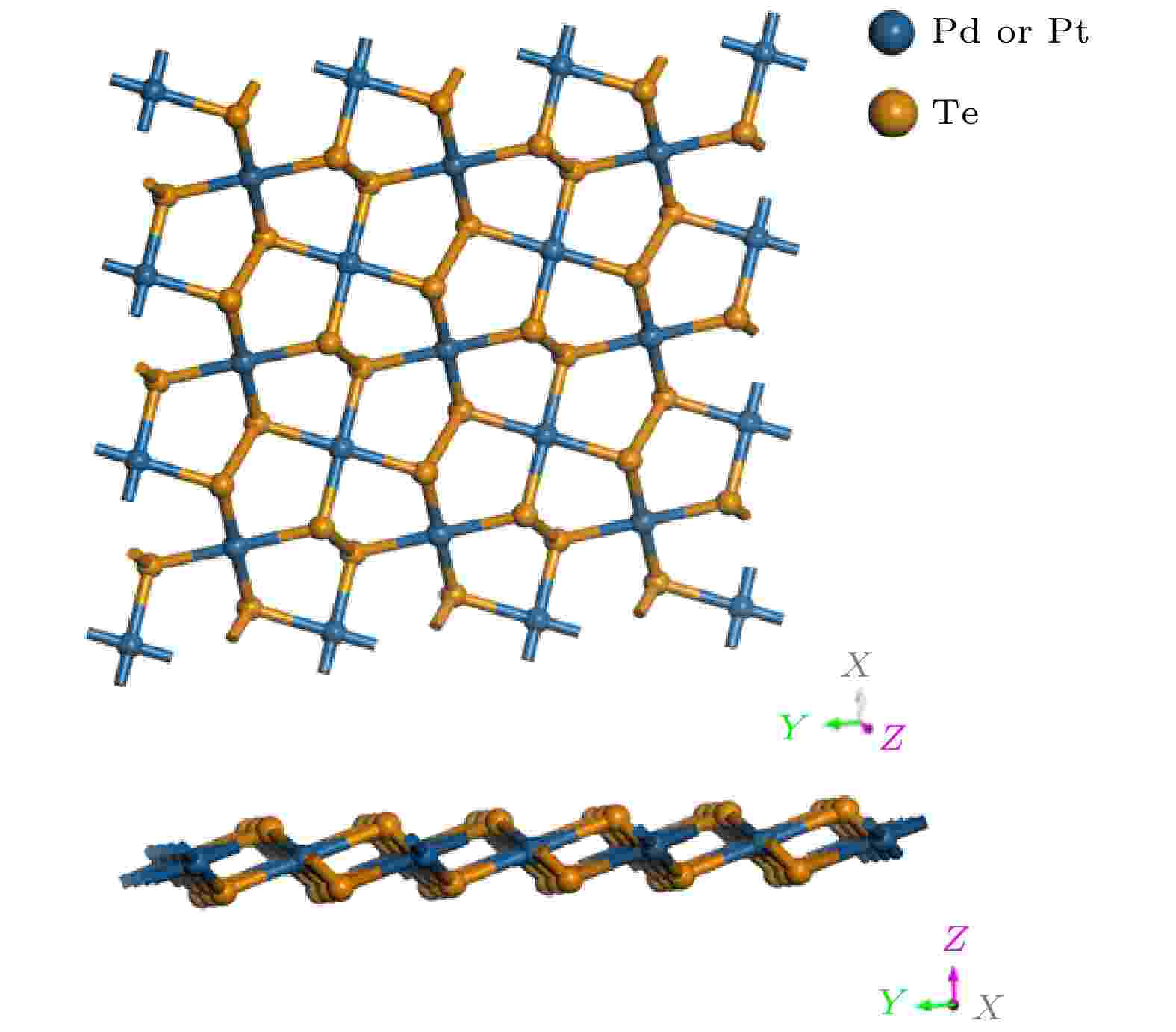
2021, 70 (11): 116301.
doi: 10.7498/aps.70.20201939
Abstract +
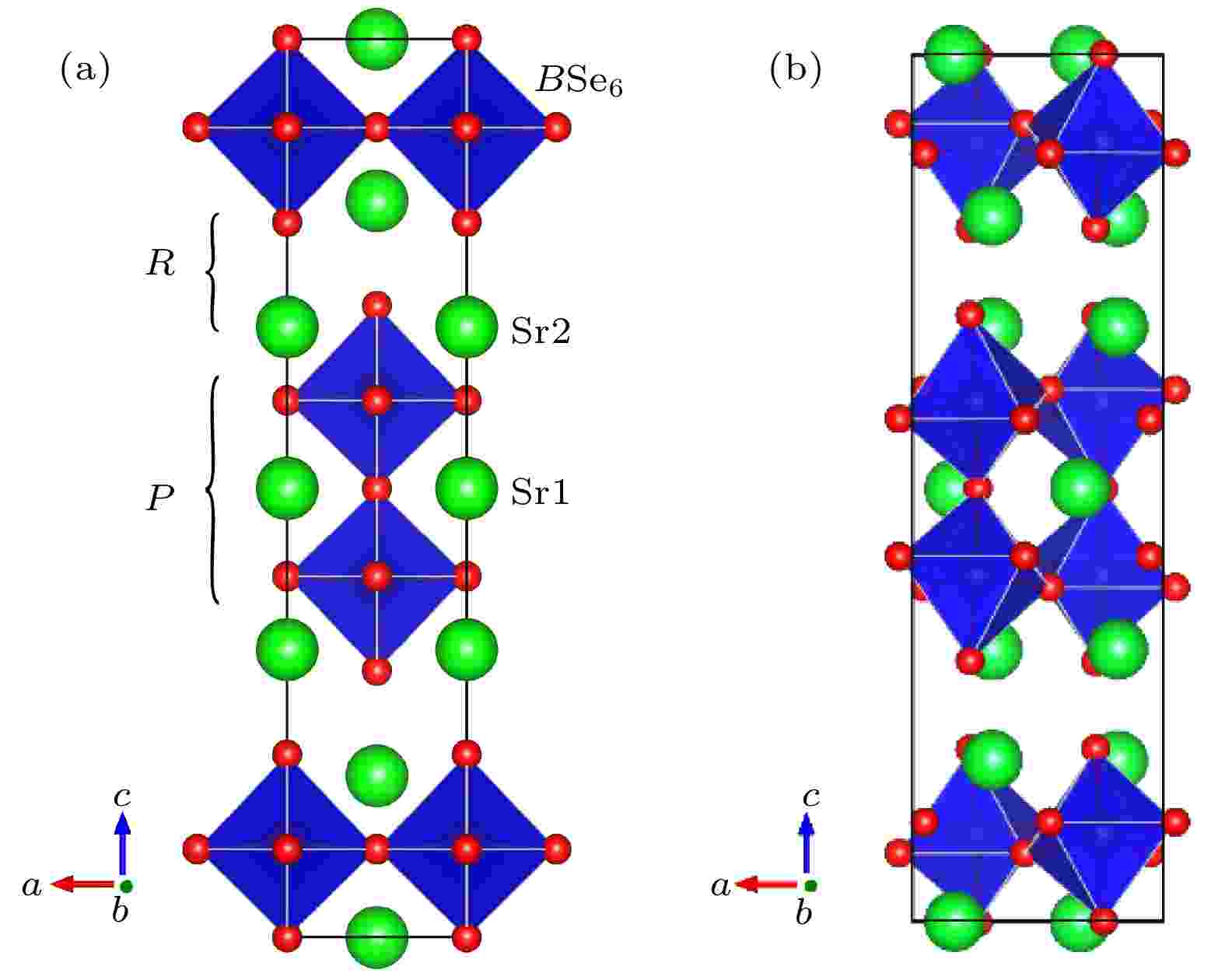
2021, 70 (11): 116302.
doi: 10.7498/aps.70.20202142
Abstract +
Recently, perovskite ferroelectric photovoltaic materials have been studied extensively. Traditional photovoltaic device usually uses the internal electric field formed by PN junction to realize the separation of photogenerated carriers to form the photovoltaic effect, while ferroelectric material, due to the existence of spontaneous polarization, can spontaneously realize the separation of photogenerated electrons and holes without the formation of PN junction, presenting the ferroelectric photovoltaic effect. Chalcogenide perovskite with suitable band gap and visible light absorption is expected to be a new generation of ferroelectric photovoltaic materials. However, its application is limited due to the lack of ferroelectric properties. Hybrid improper ferroelectricity (HIF) in layered perovskites has opened a new way for developing the new ferroelectrics. In contrast to the proper ferroelectricity in which the polarization is the main order parameter as the driving force, the improper ferroelectricity possesses the ferroelectric polarization that becomes a secondary order parameter induced by other orders. In this work, we study the ground state, electronic structure and hybrid improper ferroelectricity of n = 2 Ruddlesden-Popper (RP) Sr3B2Se7 (B = Zr, Hf ) based on the first principles. The total energy calculations and phonon spectrum analysis show that the ground state of Sr3B2Se7 (B = Zr, Hf ) is of A21am polar phase. The hybrid improper ferroelectricity originates from the coupling between two rotation modes of BSe6 octahedron. Electronic structure calculations show that Sr3Zr2Se7 and Sr3Hf2Se7 are semiconductors with direct band-gaps, which are around 1.56 eV and 1.84 eV, respectively. The ferroelectric polarization values calculated by the Berry phase method are around 12.75 μC/cm2 and 9.69 μC/cm2, respectively. The contribution of each atomic layer to the ferroelectric polarization is investigated when the Born effective charge method is used. The results show that the polarization of Sr3B2Se7 (B = Zr, Hf ) mainly comes from the Sr-Se atomic layers. To sum up, Sr3B2Se7 (B = Zr, Hf ) show strong ferroelectric polarization and good visible light absorption characteristics and they are expected to be candidates of a new generation of ferroelectric photovoltaic materials.
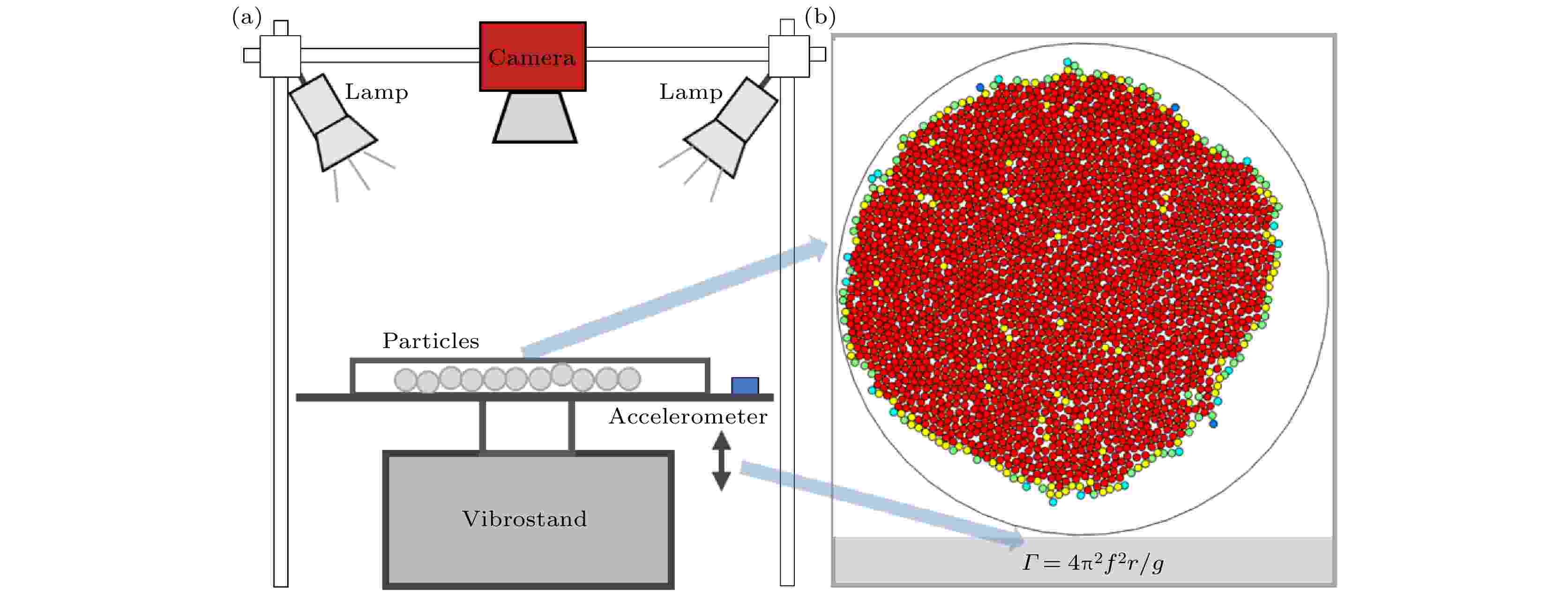
2021, 70 (11): 116401.
doi: 10.7498/aps.70.20202037
Abstract +
The study of structural defects in particle systems is of great value for studying solid-liquid melting. The volume fraction is a key parameter that can be used to accurately quantify the phase-transition process. The collective behavior and interaction form in a wet particle system are much more complex than that of a dry particle material because of the existence of liquid bridge force between the wet particles. In this paper, the structural defects and the critical value of solid-liquid transformation in the monolayer wet particles during solid-liquid melting under vertical vibration are experimentally studied. The contact model of the wet particle system is constructed according to experimental and theoretical analysis, and the structural changes of the particles in the melting process of the quasi-two-dimensional wet particle system are quantified. The Voronoi tessellation is established to study the phase transition of the particle system, and the local volume fraction is adopted to determine the state of structural defect change during melting. The experimental results indicate that the phase-transition process is caused by structural defects in the solid. The defects appear from the edge of the particle system, and the chain defect pairs spread to the center. The reason for structural defects at the edge of the cluster is that the particles at the edge of the cluster are subjected to less liquid bridge force, and the kinetic energy brought by the collision between the particles and the bottom wall makes the particles become active and begin to explore the available space. The chain defects are caused by the force chain generated by the fluid bridge force, which makes the particles tend to move together in rows. In addition, the local volume fraction of seven-phase defective particles decreases significantly and is much smaller than that of five-phase defective particles and six-phase defective particles when defects occur. Therefore, the evolution and the critical state of the structural defects can be quantified by measuring the change in the minimum local volume fraction (the local volume fraction of particles with 7-fold defects) in the particle system. The local volume fraction of the analysis shows that when the minimum local volume fraction ϕ ≤ 0.6652 defects occur, and when ϕ ≤ 0.4872 particle system transforms from solid to liquid.
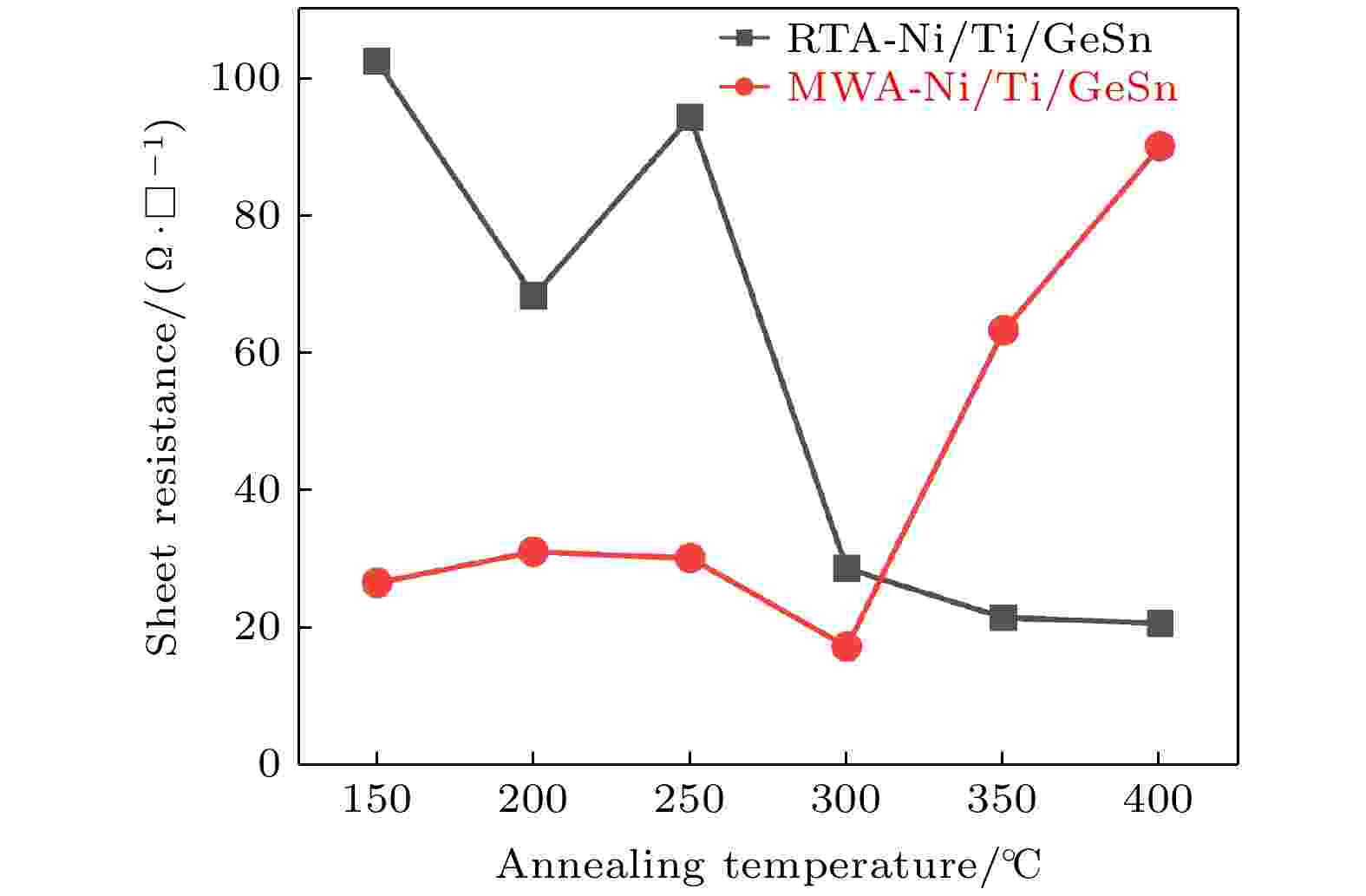
Reaction of titanium-modulated nickel with germanium-tin under microwave and rapid thermal annealing
2021, 70 (11): 116801.
doi: 10.7498/aps.70.20202118
Abstract +
As the complementary metal-oxide semiconductor (CMOS) compatible with group IV materials, germanium tin (GeSn) alloys have potential applications in photonics and microelectronics. With the increase of tin (Sn) content, GeSn alloys can change from indirect bandgap semiconductor to direct bandgap semiconductor. On the other hand, GeSn alloys have a higher hole mobility than Ge and can be used as channel materials in metal-oxide-semiconductor-field-effect transistors (MOSFETs). Therefore, the properties of GeSn alloys are studied extensively. In this work, the solid-phase reaction between Ni and GeSn is investigated under microwave annealing (MWA) and rapid thermal annealing (RTA) conditions. We use the four-point probe method to measure the sheet resistance, the atomic force microscopy (AFM) to examine the surface morphology of the sample, the cross-section transmission electron microscopy (XTEM) to analyze the microstructures of the metal stanogermanides, and energy dispersive X-ray spectrometer (EDX) to observe the elements’ distribution of different samples. It is shown that the flat Nickel stanogermanide (NiGeSn) films are obtained at 300 ℃ for MWA and at 350 ℃ for RTA. By analyzing the distributions of sample elements, we find that Sn atoms continue to diffuse into the NiGeSn layer and are segregate mainly at the interface between NiGeSn and GeSn. However, the Ti atoms move from interlayer to the surface after being annealed. We propose that this method is a promising way of developing GeSn devices in the future.

2021, 70 (11): 117101.
doi: 10.7498/aps.70.20210090
Abstract +
Recent experimental discovery of intrinsic ferromagnetism (FM) in chromium triiodide (CrI3) monolayer opens a new way to low-dimensional spintronics. Two-dimensional (2D) CrI3 monolayer is of great significance for its magnetic and electronic properties. Generally, surface atomic adsorption is an effective way to modify the physical properties of layered magnetic materials. Here in this work, we use the first-principles method based on density functional theory (DFT) to systematically study the electronic structure and magnetic properties of 2D CrI3 monolayers that have adsorbed other metal atoms (specifically, alkali (alkaline earth) metal (Li, K and Mg), transition metal (Ti, V, Mn, Fe, Co and Ni) and non-metal (N, P, O and S) atoms). Our results show that the metal atoms tend to be adsorbed in the center of the ring formed by the six I atoms and stay at the same height as Cr atoms, while the positions of the optimized non-metal atoms are in the ring formed by the six I atoms and depend on the type of the atoms. The adsorption of atoms (except for Ti and Mn atoms) does not change the intrinsic ferromagnetic semiconducting properties of CrI3 monolayer. The CrI3 monolayers with Ti or Mn adsorption are antiferromagnetic semiconductors. Moreover, we find that the adsorption of different atoms regulates the local magnetic moments of Cr atoms. The adsorption of metal atoms increases the local magnetic moments of Cr atoms, but not exceeding 4μB. However, the adsorption of non-metallic atoms makes the local magnetic moments of Cr atoms diversified. The adsorption of O and N atoms retain the local magnetic moment of Cr atoms, while the adsorption of P and S atoms increase the local magnetic moment. By combining the projected density of states, we analyze in detail the local magnetic moments of Cr atoms. The increase of the local magnetic moments of Cr atoms is directly related to the charges transferring. Our results provide new ideas for regulating the performance of the magnetism of 2D intrinsic ferromagnetic semiconductor CrI3, which will have potential applications in the spintronics in the future.
CONDENSED MATTER: ELECTRONIC STRUCTURE, ELECTRICAL, MAGNETIC, AND OPTICAL PROPERTIES

2021, 70 (11): 117102.
doi: 10.7498/aps.70.20210191
Abstract +
With the rapid development of the aerospace field, the harsh environment requires ultra-high temperature ceramic materials with better mechanical properties and ultra-high melting points. At present, the ultra-high temperature ceramic materials of single metal carbides are required more and more urgently. In order to solve the problem about the insufficient performance of transition metal single carbides, we systematically study the various physical properties of Ta1–xHfxC and Ta1–xZrxC solid solutions in an entire content range (0 ≤ x ≤ 1) based on density functional theory, including the formation energy, impurity formation energy, mixing energy, lattice parameters, elastic constants, elastic modulus, Vickers hardness, fracture toughness, wear resistance, melting point and electronic density of states. The results of formation energy show that with the increase of Hf and Zr doping concentration, the structural stability of Ta1–xHfxC and Ta1–xZrxC solid solutions gradually increase. And the structure of Ta1–xZrxC solid solution is more stable than that of Ta1–xHfxC solid solution when the doping content of Hf and Zr are the same. The results of mixing energy indicate that the formation of binary metal carbides from single metal carbides is an exothermic process. Furthermore, we also find that with the increase of Hf and Zr doping content, the lattice constant and volume of Ta1–xHfxC and Ta1–xZrxC solid solutions can expand, which is mainly attributed to the atomic radii of Hf and Zr being larger than the radius of Ta. The results of mechanical properties show that the Ta1–xHfxC and Ta1–xZrxC solid solution are brittle materials in the entire Hf/Zr content range and have mechanical stability. The bulk modulus of Ta1–xHfxC and Ta1–xZrxC solid solutions decrease with the increase of Hf and Zr content, while the melting point, Young's modulus, shear modulus, Vickers hardness and fracture toughness of Ta1–xHfxC and Ta1–xZrxC solid solutions have peaks with the doping content x = 0.2. Moreover, the addition of Hf/Zr can enhance the wear resistance of TaC. The results of the electronic density of states show that as the doping content increases, the density of states at the Fermi level of Ta1–xHfxC and Ta1–xZrxC solid solutions decrease, which also indicates that the solid solution structure becomes more and more stable.
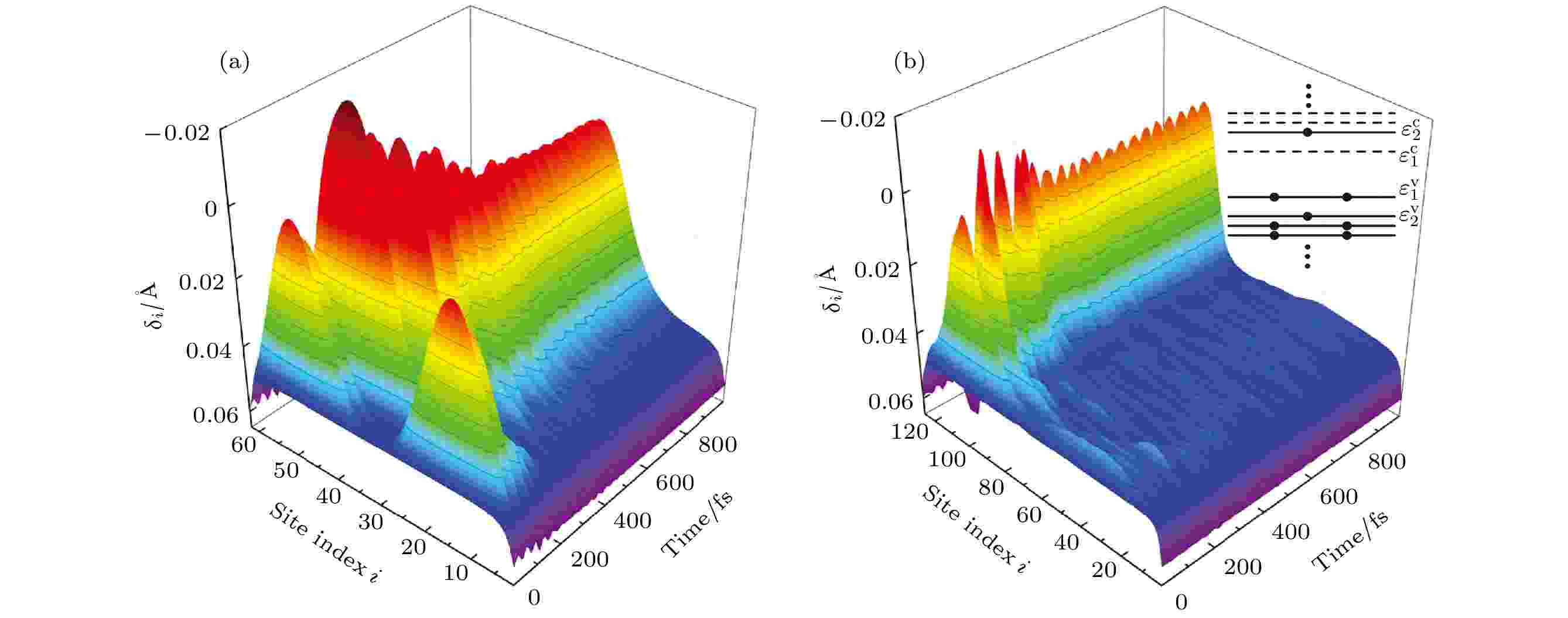
2021, 70 (11): 117201.
doi: 10.7498/aps.70.20201801
Abstract +
The luminescence efficiency of conjugated polymers has been a central topic in the study of light emitting. The effect of disorder plays an important role in generating excitons after the conjugated polymers have been excited by photons. In this paper, by using the Su-Schriffer-Heeger model, which has been modified to include intrachain disorder and electron correlation, we investigate the effects of disorder on the photoexcitation, especially on the yield of excitons in a conjugated polymer chain. We adopt the multi-configurational time-dependent Hartree–Fock method to solve the multi-electron time-dependent Schrödinger equation and the Newtonian equation of motion for the lattice vibration. The results show that after the photoexcitation relaxation process, the products of the disordered polymer chain are qualitatively distinct from those of the pure polymer chain. While the pairs of polarons can be generated directly after the photoexcitation in a pure polymer chain, the disorder favors excitons as the products of the photoexcitation, and the yield of excitons depends crucially on the kind and strength of the disorder. Furthermore, the influences of the electron correlation and the conjugation length on the yield of excitons are also discussed. Specifically, we find that in the case of diagonal disorder, when the conjugation length is short and the diagonal disorder is weak, the excitons are mainly generated by the recombination of two lattice defects with a high yield of excitons which will be reduced as the conjugation length increases. The excitons tend to be generated directly with a low yield of excitons which is enlarged as the disorder gets stronger when the conjugation length is long or the diagonal disorder is strong. The on-site Coulomb repulsion favors the generation of excitons as well. The case of off-diagonal disorder is similar to that of diagonal disorder except that the on-site Coulomb potential favors the generation of excitons in the weak disorder regime but depresses the generation of excitons in the strong disorder regime. When both diagonal and off-diagonal disorders are considered, the yield of excitons is dominated by the off-diagonal disorder. We hope that our investigations can provide useful guidance and help for designing organic photoelectric materials and devices.
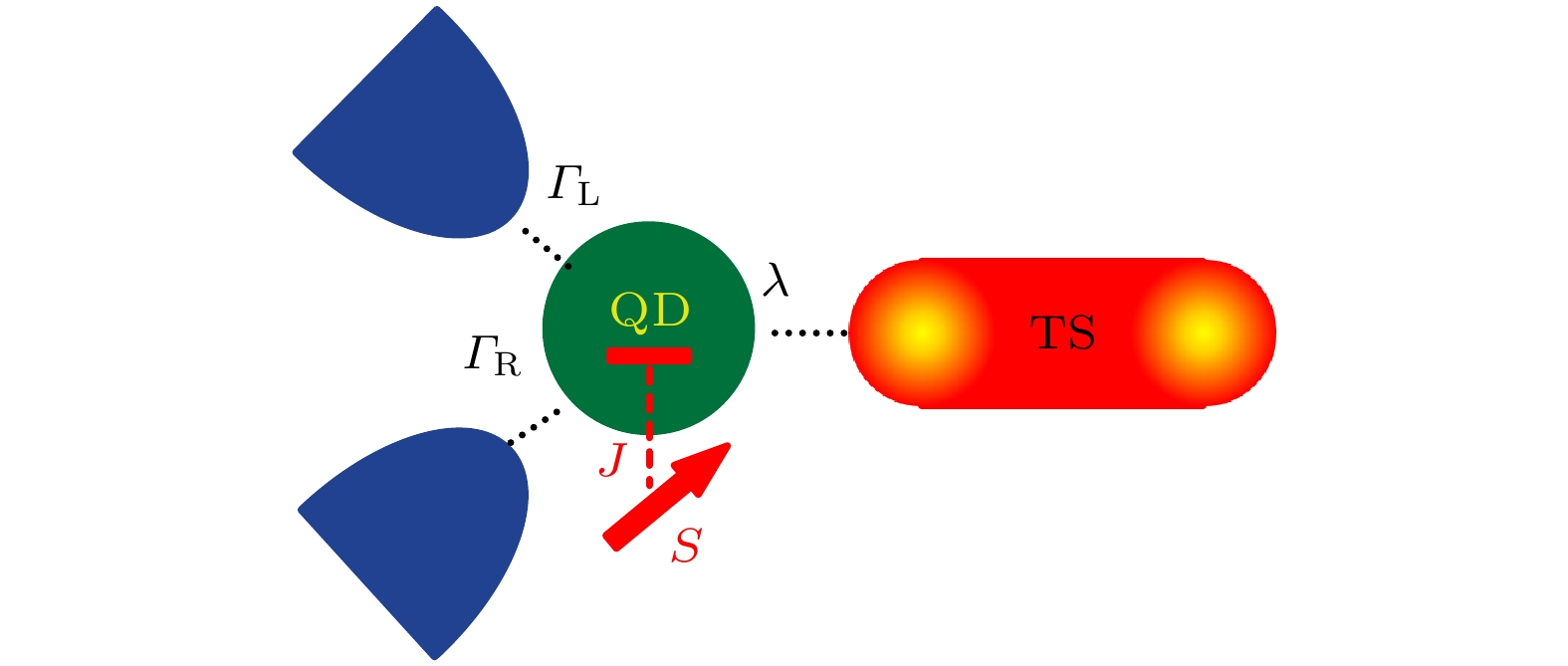
EDITOR'S SUGGESTION
2021, 70 (11): 117401.
doi: 10.7498/aps.70.20202241
Abstract +
In quantum transport, especially in spintronics, its central theme is to manipulate spin degrees of freedom in solid-state systems, to understand the interaction between the particle spin and its solid-state environments and to make useful devices. Recently, Majorana fermion has been introduced into quantum transport and received much attention. In this paper, we study a thermal-driven transport model which consists of a quantum dot coupled with two normal metal leads, a impurity spin (whose angular quantum number is more than or equal to one-half) and a Majorana fermion. We focus on the interplay between Majorana fermion and the impurity in this exactly solvable model. It is found that the system can generate thermal-induced spin current, and the currents are affected by Majorana fermion and impurity. With large temperature difference, the currents are sensitive to gate voltage, and the quantitative relation between spin-up current and gate voltage tends to be linear when the coupling between Majorana and quantum dot is strong, showing Majorana fermion's robustness. In addition, the spin current induced by Majorana fermion exhibits an oscillating antisymmetric structure around zero-bias point. This spin current’s zero point is related to the angular quantum number of impurity spin. These results are expected to be useful in thermal-electric conversion devices, and may be observed in future experiments.
INTERDISCIPLINARY PHYSICS AND RELATED AREAS OF SCIENCE AND TECHNOLOGY

EDITOR'S SUGGESTION
2021, 70 (11): 118102.
doi: 10.7498/aps.70.20210442
Abstract +
Planar array capacitance imaging system has the characteristics of uneven distribution of sensitive field, serious ill posed problem and measurement data vulnerable to external interference, and these characteristics will make the image artifacts particularly serious, affect the quality of the reconstructed image, and even determine the number of defects with difficulty. In order to solve the problem that the edge electric field and ill conditioned characteristics of planar array electrode seriously affect the quality of capacitance image reconstruction, an improved image reconstruction algorithm based on adaptive Kalman filter is proposed to reduce the noise of capacitance data and dielectric constant matrix. On the basis of constructing the state model of planar array capacitance imaging with noise, the maximum likelihood criterion is used to estimate and modify the noise variance matrix of dielectric constant matrix on-line, and the noise variance matrix of dielectric constant matrix is modified in real time. In order to restrain the filtering divergence and accelerate the convergence speed, different weighting coefficients are provided for the error covariance matrix with time going by. Through designing four kinds of samples from simple to complex structure, the defect detection experiment of composite structure is carried out. The experimental results show that compared with linear back projection (LBP), Tikhonov regularization (TR) algorithm and Kalman filtering algorithm, the image error of adaptive Kalman filtering algorithm can be reduced by about 20%, the image correlation coefficient is as high as 0.79 and the convergence speed can be improved by about 15%, the image artifacts of the four samples are greatly reduced. The experimental data show that the proposed adaptive Kalman filter image reconstruction algorithm can effectively reduce the noise of capacitance and permittivity matrix, enhance the stability of planar array capacitance imaging, and reduce the image error, so that the quality of the image can be significantly improved. This study provides a strong technical basis for improving the quantization accuracy of planar array capacitance imaging detection. In the future, we will further consider the image reconstruction under the condition of complex object field.

2021, 70 (11): 118401.
doi: 10.7498/aps.70.20201950
Abstract +
Inorganic cesium lead triiodide (CsPbI3) perovskite films show great prospect due to their high thermal stability and ideal band gap energy. To be used as a photovoltaic absorber, the CsPbI3 must form the black phase (α-CsPbI3). To prepare high-quality CsPbI3 films with phase stability in air at low temperatures, alkali metal iodides and hydroiodic acid (HI) additives are added into precursor solution. The results show that the quality and the phase stability of CsPbI3 with alkali metal iodides and HI additives are obviously improved compared with those with only HI additive. The SEM images show that the CsPbI3 film with 2.5% KI additive becomes more compact than that without KI additive and has no visible pinholes. As the KI additive increases, pinholes start to appear. From the XRD, it can be seen that the crystallinity of perovskite is improved when KI additive increases to 5.0%, while it starts to decrease with KI additive further increasing. The PL intensity of the CsPbI3 film with 2.5% KI additive is higher than the others’, implying a relatively low non-radiative recombination loss and low defect state in that film. And the CsPbI3 film with 2.5% KI additive exhibits increased absorption in the visible region, which is beneficial to enhancing the efficiency of perovskite solar cells. Considering the SEM images, crystallinity, PL intensity and light absorption of perovskite, the optimized KI additive is 2.5% in our work. For the CsPbI3 film with NaI additive, the SEM images show that the films become more compact and have no visible pinholes when NaI additive is 5%. As the NaI additive increases, pinholes appear. The crystallinity of perovskite increases with NaI additive increasing. The PL intensity of the CsPbI3 film with 5% NaI additive is higher than the others’, implying lower defect states in films. And the CsPbI3 film with 5% NaI additive exhibits the improved absorption in the visible region. Considering the SEM images, crystallinity, PL intensity and light absorption of perovskite, the optimized NaI additive is 5%. Therefore, adding alkali metal iodides and HI is an effective method to further improve the stability and efficiency of CsPbI3 perovskite solar cells.

2021, 70 (11): 118501.
doi: 10.7498/aps.70.20201829
Abstract +
GaInAsSb quaternary alloys have attracted much interest in infrared optoelectronic applications due to their versatility in a large range of energy gaps from 0.296 eV to 0.726 eV when lattice matches to GaSb wafer. However, due to the high intrinsic carrier concentration and Auger recombination, GaInAsSb p-n junctions typically are characterized by high dark current density at room temperature and need to be operated at low temperature to obtain high optoelectronic performance. In this work, a front surface wide-bandgap semiconductor nano pillar array (NPA) and a high reflective metal back surface reflector (BSR) are designed to modulate optoelectronic performances of GaInAsSb p-n junction. The optical and optoelectronic characteristics are analyzed by the finite difference time domain simulation and the numerical solution of carrier transport equations, respectively. It shows that the NPA-BSR structure can trigger Mie-type resonance, Wood-Rayleigh anomaly effect and Fabry-Perot resonance, which can be used to trap the light efficiently in an ultrathin GaInAsSb film. Owing to these nanophotonic effects, the average light absorption of ~90% can be obtained in 1.0–2.3 μm infrared waveband for 1μm Ga0.84In0.16As0.14Sb0.86. It also shows that the Auger recombination can be suppressed with thickness decreasing which leads the carrier collection efficiency to increase and the dark current density to decrease. Theoretical results show that the carrier collection efficiency of ~99% and dark current density of ~5×10–6 A/cm2 can be obtained for the 1 μm Ga0.84In0.16As0.14Sb0.86 p-n junction. With these unique optoelectronic properties, the NPA-BSR nanophotonic structure can become a very promising method to realize the high performance ultrathin GaInAsSb infrared optoelectronic devices.
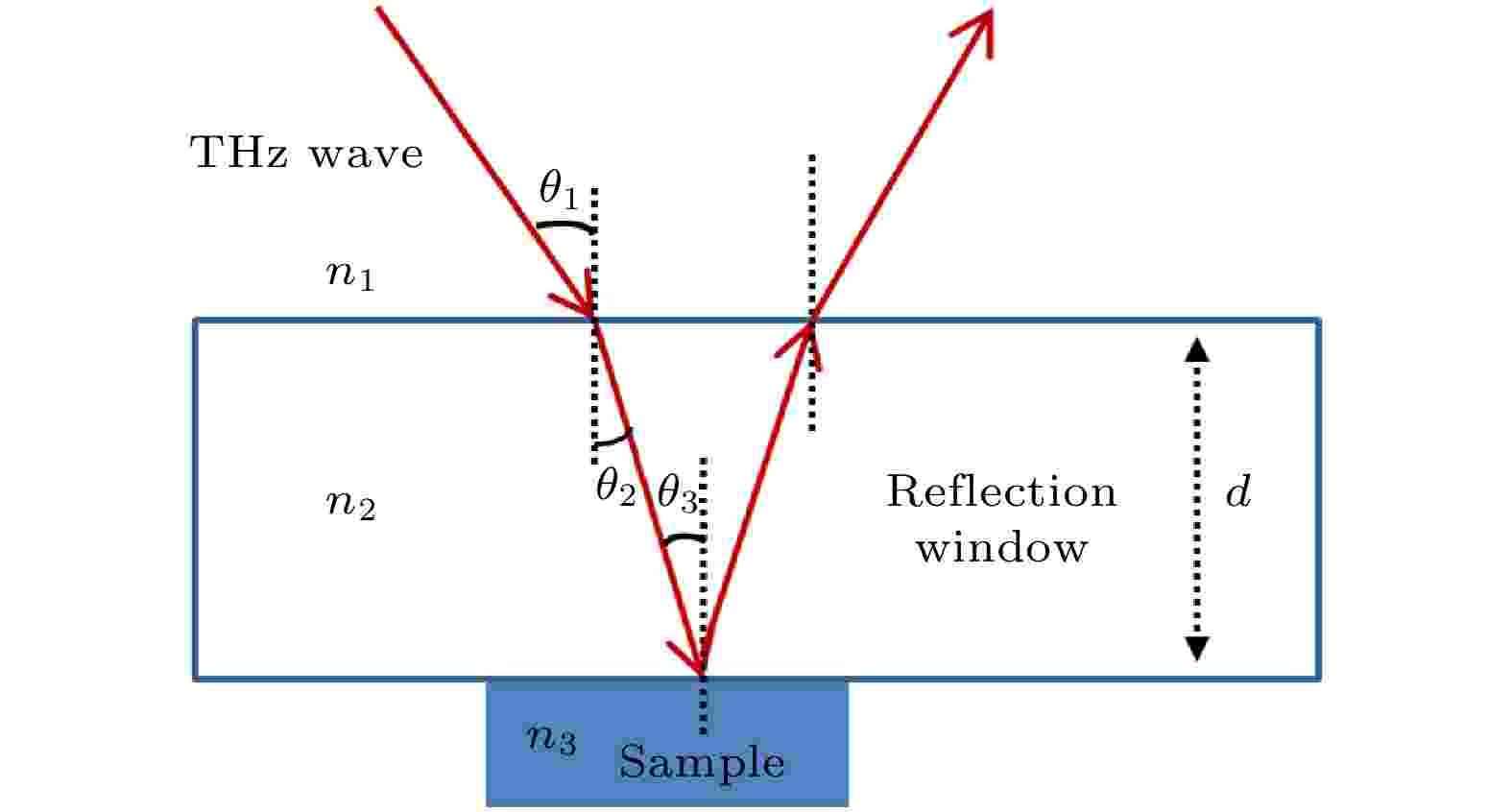
EDITOR'S SUGGESTION
2021, 70 (11): 118701.
doi: 10.7498/aps.70.20210182
Abstract +
Terahertz imaging technology is one of the candidate technologies for medical imaging. In particular, continuous terahertz reflection and attenuated total reflection imaging are expected to achieve rapid intraoperative imaging, which is hot research topic at present. In order to realize the rapid multi-dimensional and high-quality terahertz imaging detection of sample, it is necessary to study the common optical path continuous terahertz reflection/attenuated total reflection dual-mode imaging system based on point scanning. By using the Fresnel formula and the penetration depth formula of evanescent wave, the influence of imaging angle on the reflected signal and the penetration depth of attenuated total reflection are studied theoretically in this paper. The imaging angle of terahertz wave suitable for both reflection and attenuation total reflection imaging is obtained. Based on this, an isoscele total reflection prism with a base angle of 49° is designed. The dual-mode imaging of common optical path continuous terahertz reflection and attenuated total reflection is realized by quickly switching between reflection window and total reflection prism. The reflection and attenuation total reflection imaging modes have imaging resolutions of 400 μm and 500 μm, respectively. Continuous terahertz reflection and attenuated total reflection imaging are experimentally studied by using distilled water and pork as samples. The results show that the relative reflectance of the sample obtained in the attenuated total reflection imaging mode fluctuates within a range of 1%, and the image contrast is 9 times that of the reflection imaging mode. Moreover, attenuated total reflection imaging can effectively identify the sample with the length less than 1 mm. Thus, compared with reflection imaging, continuous terahertz attenuated total reflection imaging has the advantages of high image resolution, high image contrast and highr signal stability, and can accurately obtain the reflectivity of sample. The terahertz attenuated total reflection imaging technology is more helpful in achieving high sensitivity imaging of samples. By combining reflection and attenuated total reflection imaging modes, the advantages of different imaging modes can be compensated for and the performance of the imaging system can be further improved. This common path continuous terahertz reflection and attenuated total reflection dual mode imaging system is expected to achieve a high sensitivity detection of sample.
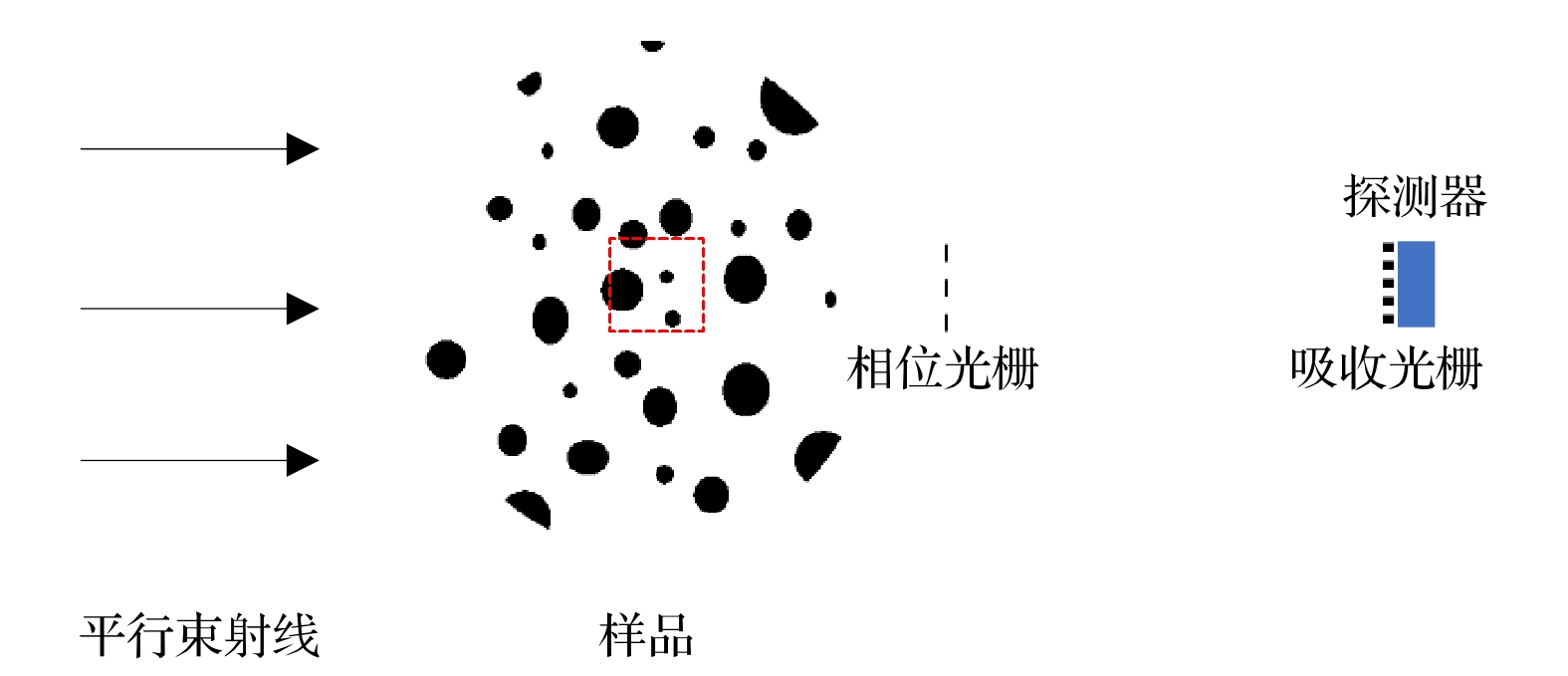
EDITOR'S SUGGESTION
2021, 70 (11): 118702.
doi: 10.7498/aps.70.20202192
Abstract +
X-ray differential phase contrast computed tomography imaging based on grating interferometer system can reconstruct not only the linear attenuation coefficient, but also the phase shift coefficient and the linear scattering coefficient of the object. In practical application, it is very difficult to make a large area grating, so the sample is often larger than the grating. When the sample is scanned with a grating smaller than the sample, the part of the sample beyond the field of view of the grating will cause the differential phase projection information to be truncated. In this paper, a method of reconstructing the region of interest for differential phase contrast computed tomography is proposed. The method is based on the approximate linear relation between the phase shift coefficient of the object and the linear attenuation coefficient (i.e. the decrement in the real part of the refractive index and the imaginary part of the refractive index), the phase shift coefficient of the region of interest is approximately reconstructed by the polynomial of Lambda function of the phase shift coefficient and Lambda inverse function of linear attenuation coefficient. In this paper, according to the Fresnel diffraction theory and differential phase grating phase step-by-step method of imaging a simulation experiment is performed. In the experiment, conducted is the approximate reconstruction by using the first order polynomial and quadratic polynomial of Lambda function of the phase shift coefficient and Lambda inverse function of linear attenuation coefficient. The sample size is five times of grating imaging field, and the results show that this method can approximately reconstruct the region of interest for the sample image. We also carry out the actual data experiment. The actual data are obtained by the Talbot grating interferometer system of Shanghai synchrotron radiation BL13W1 station, and the standard model and biological sample are imaged. The method of reconstructing the region of interest is proposed in this paper. This method can be applied to the multi-material samples with a similar relationship between the decrement in the real part of the refractive index and the decrement in the imaginary part of the refractive index, and also to single-material samples. The comparison between the numerical simulations and the actual experimental results verifies the effectiveness of the proposed method.














